 24/03/2011 21:45 24/03/2011 21:45 |
|
| | | OFFLINE | | Post: 22.355
Post: 4.980 | Registrato il: 28/08/2005
Registrato il: 20/01/2009 | Administratore | Utente Master | |
|



 Inclement skies over Berlin:
Inclement skies over Berlin:
Prospects for the Pope's visit
Translated from

24/03/2011
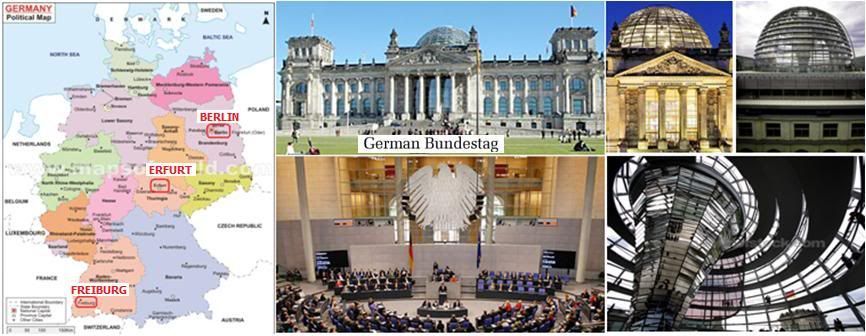
BERLIN - With Benedict XVI, it seems that raising the bar, 'the harder it is', works for him. [The context is his apostolic visits abroad where he has always ended reaping blessed success from the media-hyped and -generated minefields of dissent preceding each visit to a secularized nation.]
In September, Germany, his homeland, expects him, with Berlin at the center of this official visit.
This is an enigmatic city, an explosive cocktail of various essences - cold Prussian rigor, Marxist ideology and its existential emptiness, a cultural ferment that is always in protest against tradition, and a kind of countercultural underground that accommodates the proud technology of a city launching itself at full throttle into the future, perhaps because its past is full of disturbing ghosts.
In the context of Catholic history, Berlin has been an emblem of the Kulturkampf (culture war) with its atavistic anti-Roman hostility which has always found especially fertile humus on German soil.
Quite a setting for the coming visit of the Pope born in Bavaria, for the theologian who has unravelled the complex threads of the widespread malaise in society today (malaise which takes very little to generate a torrent of social disasters).
But he wants to go, he knows he has to go to Berlin, precisely. He told his fellow Bavarian peter Seewald, "Yes, the flock there is under pressure, but if the Lord still gives me the necessary strength, I would gladly go". [This was in their July 2010 interview before the visit in September 2011 was officially announced.]
If we just go by mere sociological analyses, the prospects look desolate. The break from long-established Christian roots is almost scandalous in Germany, the values of 1968 have worked sweeping changes in the family, and the emotion that followed the fall of the Berlin Wall has given way to a savage pragmatism.
German Catholics do not have a clear-minded leadership to counter these tides. Their theologians seem anchored to the controversies of the 1970s, their bishops have found it difficult to change their mission parameters to be more in harmony with the post-Conciliar Popes, and the penetration into society of the relativistic mindset has wrought havoc.
Moreover, it is a time of imminent crucial changes in the German episcopate. Cardinal Joachim Meisner of Cologne (a great friend of the Pope), is nearing retirement, and in Berlin itself, the Archbishop, Cardinal Sterzinsky, had to retire early because of illness.
Difficult decisions face the Pope on the eve of one of his most anticipated trips, because he needs a more compact German episcopate to energize a new mission.
But there still exists a small flock - in the Biblical sense, not numerically - intent on living their faith with fidelity, who adhere simply to the Christian witness of Benedict XVI himself, who already live not as defenders of terrain that is being wrested from them, but simply by continuing to offer the unconsidered novelty of Christianity i a society that no longer knows it. This flock is under pressure, yes, and that is why their shepherd cannot fail them.
But some German Catholics have already started to lay down the explosives they intend to detonate when the Pope comes. First, those German theologians with a manifesto as musty as dirty linen kept too long in the closet. And some Parliament members of the Christian Democratic Union - adult Catholics, of course - who are demanding a special exemption from priestly celibacy for German priests, and some of his hosts like Berlin Mayor Klaus Wowereit who says he will publicly confront the Pope for his 'closed mind' regarding homosexuality.
Meanwhile, we await the Pope's address to the German Bundestag, which will be an event for the history books on many counts.
But even our Protestant brothers have something to say about the Pope's visit. The chairman of the Lutheran Evangelical Council for Germany, Nikolaus Schneider, wrote the Pope to complain that the current draft of the Pope's schedule only allows an hour for him to meet with the leaders of non-Christian religions in Germany.
The Pope replied in writing to assure Schneider that he will give the appropriate priority to ecumenical affairs during the visit, despite "a program that is already crowded".
In any case, there is much noise and much stirring even now in the months preceding a visit that will likely be a minefield for the Pope.
But even as the powers-that-be seem to mistrust the Pope, a recent survey by the Forsa institute showed that 29% of all Germans have 'great confidence' in Benedict XVI, a figure much higher than the 12 and 18% who trust their economic managers or political leaders, or even the other ecclesiastical authorities in Germany.
Among German Catholics, 50% believe that Papa Ratzinger is 'highly credible' against only 21% who think so of the Church as an institution.
These are figures that should make the reformists and progressivists think twice, since they always claim to represent the faithful who are supposed to be in revolt against Rome.
[I have not had time to check out an executive summary of the Forsa survey, but if 29% of all Germans polled had 'great confidence' in the Pope, one presumes there are also those who answered they had 'confidence' or 'some confidence' in him, which would make the confidence figures greater. Likewise, among German Catholics, if 50% believe he is 'highly credible', there must also be those who think he is 'credible' or 'somewhat credible. Let's say these bring up the 50% to something like 60-70%, conservatively. That would leave about 30-40% who do not believe him at all.
While that is a distressing figure about Catholics in any country, it does not appear to reflect the massive rejection of Catholicism that news reports make it seem whenever they gloat over the number of German Catholics who have officially 'left' the Church (in practical terms, if I understand it right, it means they no longer have to designate part of their tax payment to the Catholic Church). The low approval for the Church as an institution reflects the prevailing liberal-secular mindset that opposes the Church policy on most social issues. And yet, the Pope represents all those issues par excellence!]
Alongside the 'small flock' of Germans who clamor to be confirmed in their faith, the Pope is also thinking of the ordinary people, those whom the intellectuals in vogue do not represent, nor are they reported upon by the dominant media.
These are people whose traditional culture has been eroded mercilessly in the past few decades, but who have not lost the folk instinct to know who is telling the truth, who seeks to light a candle in the midst of darkness.
Those people, given the opportunity, will want to see and hear Benedict XVI in Erfurt, in Freiburg, and even in Berlin.
For them, the Pope will take the risks, known and unknown, because he knows that the cause of faith stands to gain from his physical presence during those four days in September.
Most especially, Benedict XVI moves primarily in the territory of the heart, where the perennial questions of man reside, where there is some presentiment of the truth that it hopes for, where the hunger and thirst for the Infinite have not been washed out by 40 years of pure unadulterated ideological acid.
[Modificato da TERESA BENEDETTA 24/03/2011 21:50] |
| |
|
| |
 25/03/2011 00:13 25/03/2011 00:13 |
|
| | | OFFLINE | | Post: 22.356
Post: 4.981 | Registrato il: 28/08/2005
Registrato il: 20/01/2009 | Administratore | Utente Master | |
|
 Kudos to Angela Ambrogetti for having had the brilliant idea to do a book of this kind, in view of all the available material just lying in the archives. And a bit strange that no male Vaticanista thought about doing this, so more power to her.
'Travelling companions:
Kudos to Angela Ambrogetti for having had the brilliant idea to do a book of this kind, in view of all the available material just lying in the archives. And a bit strange that no male Vaticanista thought about doing this, so more power to her.
'Travelling companions:
In-flight interviews
with John Paul II'
Edited by Angela Ambrogetti
Foreword by
FR. FEDERICO LOMBARDI, S.J.
Translated from the 3/24/11 issue of
 Editor's Note: Yesterday evening, at Vatican Radio headquarters in Rome, the book entitled Compagni di viaggio. Interviste al volo con Giovanni Paolo II (Libreria Editrice Vaticana, 2011, 389 pp), edited by Angela Ambrogetti, was formally presented. Here is the Foreword to the book written by Vatican Radio director Fr. Federico Lombardi [now also the Vatican press officer, but Vatican Radio director since ...
Editor's Note: Yesterday evening, at Vatican Radio headquarters in Rome, the book entitled Compagni di viaggio. Interviste al volo con Giovanni Paolo II (Libreria Editrice Vaticana, 2011, 389 pp), edited by Angela Ambrogetti, was formally presented. Here is the Foreword to the book written by Vatican Radio director Fr. Federico Lombardi [now also the Vatican press officer, but Vatican Radio director since ...
Since Vatican Radio has the task of recording and disseminating the voice of the Pope around the world, its central archive is of audio recordings is naturally dedicated essentially to the Popes.
The different language sections of RV also preserve other interesting recordings in their own languages, interviews with bishops and other authorities, or events concerning the people to whom their programs are aired.
But the central archive has a very clear institutional task: to preserve audio recordings of the Popes. These constitute a valuable asset for the Church.
The technology of audio recording and archiving has changed rapidly and profoundly with time. Decades ago, it required cumbersome instruments with physical support hat was not easily manageable nor very reliable to preserve the recording.
For instance, we have a collection of what we call 'paddeloni' (frying pans), which are large vinyl discs containing various ceremonies recorded in the time of Pius XII.
It is no surprise than the recordings kept in the first decades of RV's life [since 1939], although numerous and valuable, correspond only to a tiny fraction of the addresses and activities of the Popes
in that ear.
In time, however, the task has become much easier. And even the attitude towards the conservation of recordings - both audio and video - has become far more consciously attentive.
John Paul II's Pontificate was probably the first to be documented systematically and almost completely in audio recordings which were used generously in our broadcasts but also classified and preserved with care.
The technicians of Vatican Radio have been increasingly committed to recording even the briefest and most extemporaneous of what the Popes say - things that in the past it was not considered necessary to record.
Because of this, besides the length and intensity of the Pontificate, the part of our sound archives dedicated to John Paul II is indisputably the major part of the entire archive - at least 70% of it.
His trips were of course the most demanding part in audio documentation. It is one thing to tape events at the Vatican and at audiences, and quite another to keep up with a Pope who was bursting with activity and creativity, in various parts of the world and in the most diverse of situations.
But Vatican Radio did all it could to be there with him. The result is that, as much as everyone thinks that everything has been said and published about John Paul II, that is not true.
The amount of new material that can now be revealed and appreciated with calm and attention is not at all inconsiderable. Among this are the recordings of his interactions with newsmen who flew with him on his various travels, and they are perhaps among the most interesting.
Today, the words Benedict XVI addresses to newsmen in-flight during his travels are simultaneously taped by the newsmen themselves, and often immediately reported by phone or Internet to their editors, and are shortly afterwards, published almost in full in L'Osservatore Romano and the Vatican bulletins.
But for several years, it was not so, also because John Paul II engaged in extemporaneous exchanges, many of them brief quips. It was not the sort of thing that needed to be reported or even to be taped by the newsmen. Fortunately, we at Vatican Radio did tape most of it and they are easily accessible to listen to.
Therefore, I approved the offer made by Angela Ambrogetti to go through the recordings and transcripts of John Paul II's in-flight interviews and remarks in order to publish the most interesting parts in a book. Such a systematic approach had not been done, and it has certainly been worth doing.
Cardinal Roberto Tucci, who was the first organizer of John Paul II's foreign travels, as well as a privileged witness of most of those travels, has told he that he considers this book a rare and effective testimonial to the personality and ideas of Papa Wojtyla.
He emerges in the book with great freshness 'as he was', with his extraordinary spontaneity and expressive freedom, his goodhearted and direct approach to others, even to that special genre of mankind that newsmen constitute.
An item on the LEV site adds the following information about the book:
What John Paul II
said in-flight
Translated from

March 23, 2011
Presenting the book at Vatican Radio this afternoon are Cardinal Roberto Tucci, who was John Paul II's first papal trip organizer; Paloma Gomez Borrero, who reports on the Vatican for Spanish TV (and was the first female journalist to travel with John Paul II on one of his trips); Don Giuseppe Costa, director of LEV; and Gianfranco Svidercoschi, veteran Vaticanista from John Paul's time and co-author of Cardinal Dsiwisz's memoir on John Paul II. Fr. Lombardi moderated.
Thanks to the Vatican Radio archive, Ms. Ambrogetti has reconstructed pages of a true 'Magisterium on the wing' of a Pope who inaugurated a new way of communicating.
His ample replies and summary expositions, rapid quips as well as interviews touching on the most topical issues of geopolitics, theology or the history of the Church, live again in the pages of this book, allowing the reader to feel the humanity and liveliness of the late Pope.
Subdivided according to the continents he visited, the book also includes authoritative testimonials such as that of Cardinal Stanislaus Dsiwisz, who was private secretary to John Paul II for 40 years, and an interview with Ms. Borrero, who covered practically all of John Paul II's trips and continues to cover Benedict XVI.
There is an appendix listing all the travels of John Paul II and brief biographies of the newsmen who are involved in the interviews and conversations.
More than 40 photographs also help the reader to relive the atmosphere of those encounters.
NB: Between now and the beatification, I will be posting all news reports about John Paul II on this thread.
 Late last year, the Vatican publishing house LEV started a new fancy site other than the web pages they have within the main Vatican site and stopped updating their feature NOVITA EDITORIALI (new publications0 which was updated monthly on the old site. The analogous entries in the new site did not carry the covers which the old site had, and without the visual, there was no incentive to post them. Every time I checked, the old site NOVITA was still frozen in October, so I stopped looking. Now they have resumed the NOVITA on the old site and are now up to date - about time.
Late last year, the Vatican publishing house LEV started a new fancy site other than the web pages they have within the main Vatican site and stopped updating their feature NOVITA EDITORIALI (new publications0 which was updated monthly on the old site. The analogous entries in the new site did not carry the covers which the old site had, and without the visual, there was no incentive to post them. Every time I checked, the old site NOVITA was still frozen in October, so I stopped looking. Now they have resumed the NOVITA on the old site and are now up to date - about time.
Here then are the new LEV publications on and by Benedict XVI since October.
Benedict XVI and JPII
books from LEV
From the webpage of

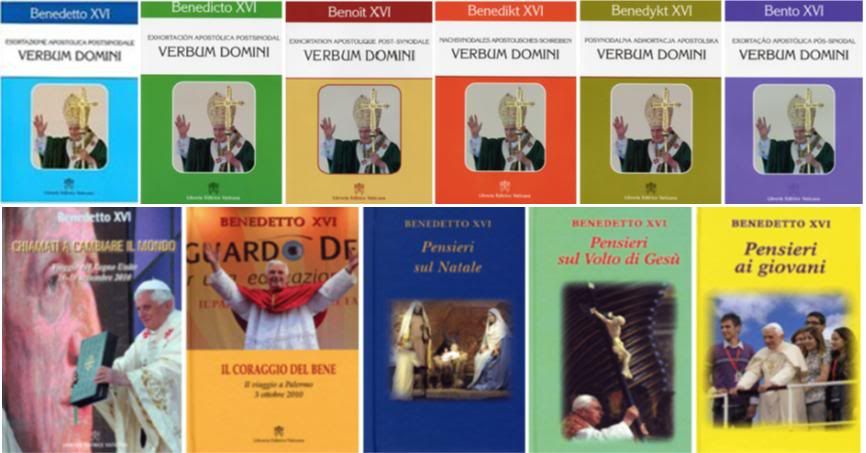
October and November saw the publication of the Post-Synodal Apostolic Exhortation on the Word of God, Verbum Domini, in eight languages. (Unfortunately, the photos for the English and Latin versions are not available.) These were followed by the two books containing all the papal texts for his apostolic visits to the United Kingdom and Palermo; and three more of the Pensieri... (Thoughts of Benedict XVI) booklets, of which there are probably at least two dozen by now - these latest ones on Christmas, the face of Christ, and for and about young people.
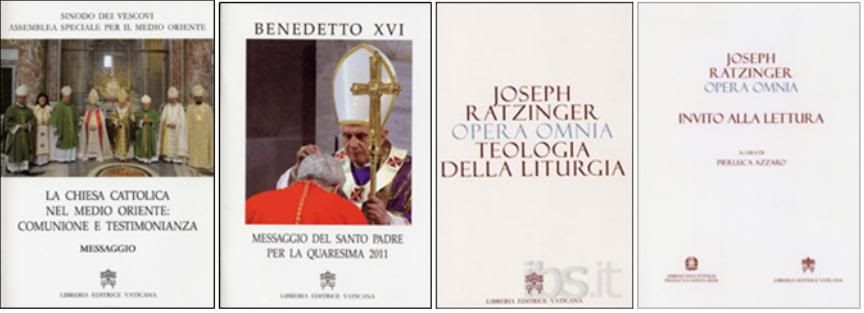
In January and February, LEV published the Holy Father's Message for the Special Assembly of the Bishops' Synod on the Middle East in October, and his Lent message for 2001, but the major event was the launching of the Italian edition of Joseph Ratzinger's Opera Omnia (Collected Works) - everything published before he became Pope; and an Invito alla Lettura (Invitation to read Joseph Ratzinger/Benedict XVI), a collection of essays by Italian writers introducing the Opera Omnia.
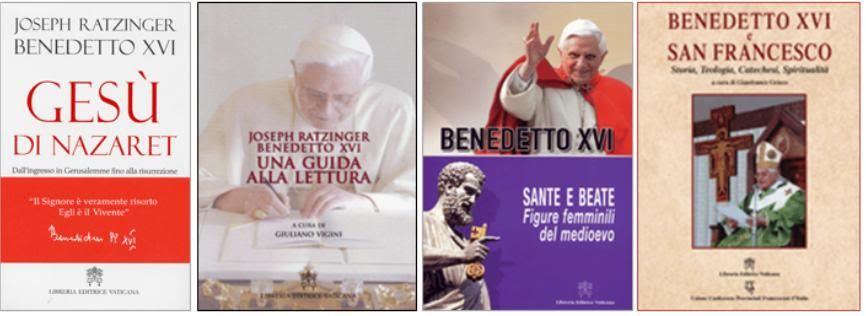
March has turned out a book bonanza - JON-2, and a companion guide to reading it; SANTE E BEATE: Figure femminile del Medioevo, the Holy Father's catecheses on outstanding Catholic women of the Middle Ages - the seventh in the series LEV has been publishing of the Pope's catecheses since THE APOSTLES; and an unexpected bonus: Benedetto e San Francesco, putting together all of Benedict XVI's texts and remarks about Francis since he became Pope. [When the Pope announced on New Year's Day that he was planning an Assisi event in October, I had commented here that he had already devoted a significant amount of reflections on St. Francis to warrant a book. I am so glad someone has done it.]

Also in March, Cronaca dei giorni di luce: Benedetto XVI e Giovanni Paolo II (Chronicle of the days of light), a new account of the events in April 2005 from the death of John Paul II on April 2 to the election and inauguration of Benedict XVI; Compagni di viaggio, as described above; and an intriguing Dono e Mistero: Diario d'un sacerdote (Gift and mystery: Diary of a priest) bylined Karol Wojtyla. Unfortunately, no information is given about it.
[Modificato da TERESA BENEDETTA 25/03/2011 22:11] |
| |
 25/03/2011 13:04 25/03/2011 13:04 |
|
| | | OFFLINE | | Post: 22.357
Post: 4.982 | Registrato il: 28/08/2005
Registrato il: 20/01/2009 | Administratore | Utente Master | |
|
 Vatican launches public
Vatican launches public
dialogue with atheists
by Tom Heneghan

PARIS, March 24 (Reuters) - The Vatican launched a series of public dialogues with non-believers on Thursday, choosing leading intellectual institutions in Paris to present its belief that modern societies must speak more openly about God.
The decision to start the series in France, where strong secularism has pushed faith to the fringes of the public sphere, reflected Pope Benedict's goal of bringing religious questions back into the mainstream of civic debates.
The dialogues, called "Courtyard of the Gentiles" after the part of the ancient Temple in Jerusalem where Jews and non-Jews met, will continue in at least 16 cities in Europe and North America over the next two years.
Cardinal Gianfranco Ravasi, the Vatican's culture minister, told participants at the United Nations Educational, Scientific and Cultural Organisation (UNESCO) the dialogue was meant not to confront believers and atheists but to seek common ground.
Rather it was "an invitation to non-believers ... to start a voyage with believers through the desert," he said.
The meeting was due to continue on Friday with sessions at the Sorbonne university and the Institut de France, home of the prestigious Academie Francaise.
Pope Benedict, who recently launched another Vatican drive to revitalise the faith in traditionally Catholic countries, proposed these meetings with non-believers in 2009.
"We must be concerned that human beings do not set aside the question of God, but rather see it as an essential question for their lives," he said in a speech to the Vatican hierarchy.
"We must make sure that they are open to this question and to the yearning concealed within it."
Addressing the UNESCO meeting, former Italian Prime Minister Giuliano Amato said a so-called honour killing in his country, in which a Pakistani murdered his daughter for behaving as freely as Italian youths, presented a challenge to open democracies that believers and atheists had to think about.
"Democratic societies are founded on the hypothesis that everyone can differentiate between just and unjust, good and evil, and everyone can find the limits" he said. "If one is no longer conscious of this, then democracy doesn't work anymore."
Although he said Christianity offered a moral compass, Amato did not present it as the only way to counter the problems challenging affluent liberal societies.
Even Ravasi, despite his Roman collar, did not present his views as a sermon for more Catholicism. Instead of the Gospels, he quoted secular thinkers such as the German poet Johann Wolfgang von Goethe, the Austrian philosopher Ludwig Wittgenstein and the Argentinian novelist Jorge Luis Borges.
The discussions are due to end on Friday evening with a youth rally outside Notre Dame Cathedral highlighted by a video address by the Pope from Rome.
Further dialogue meetings are planned in Italy, Albania, Sweden, Czech Republic, Germany, Switzerland, Canada, Spain, Russia and the United States.
[Modificato da TERESA BENEDETTA 25/03/2011 13:04] |
| |
 25/03/2011 14:27 25/03/2011 14:27 |
|
| | | OFFLINE | | Post: 22.358
Post: 4.983 | Registrato il: 28/08/2005
Registrato il: 20/01/2009 | Administratore | Utente Master | |
|
 Friday, March 25, Second Week in Lent
FEAST OF THE ANNUNCIATION
Friday, March 25, Second Week in Lent
FEAST OF THE ANNUNCIATION
 The Annunciation by Fra Angelico, 1437; Botticelli, 1489; Raphael, 1501
'FIAT VOLUNTAS TUA!...ET VERBUM CARO FACTUS EST'
Readings for today's Mass: www.usccb.org/nab/readings/032511.shtml
The Annunciation by Fra Angelico, 1437; Botticelli, 1489; Raphael, 1501
'FIAT VOLUNTAS TUA!...ET VERBUM CARO FACTUS EST'
Readings for today's Mass: www.usccb.org/nab/readings/032511.shtml
OR today.
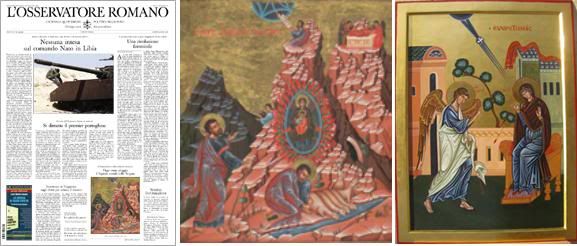 Page 1 features an 11th-century Russian icon (center) in which the mystery of the Incarnation is presented in the Burning Bush of the Old Testament. A front-page essay on the Annunciation in the Byzantine tradition. in which the Annunciation/Incarnation is described as 'the Lord fell like rain over the Virgin'. From the OR online post, one would conclude that there is no story about the Pope in this issue when, in fact, there is a summary of Mons. Gerhard Mueller's presentation of JON-2 at the Diocese of Rome's 'Dialogues in the Cathedral Thursday night, reproduced on Lella's blog from the paper edition. Page 1 international news: 'No-fly zone' coalition nations in discussions to turn over military command of anti-Qaddhafi operations to NATO (the agreement was reached last night, hours after this issue went to press); increasing uncertainty whether Japan will be able to control what appears to be a worsening situation at the damaged Fukushima nuclear plant; the Portuguese prime minister resigns after Parliament rejects the debt crisis resolution negotiated with the European Union. In the inside pages, German Chancellor Angela Merkel says Germany will stop further nuclear-plant plans; a terrorist bomb near a Jerusalem bus stop kills one woman and wounds dozens in the first such attack in three years since Israel put up the wall between the city and adjoining Palestine territory; and a tribute to Elizabeth Taylor, who died in Los Angeles yesterday at age 79. [MSM will probably report this signed article as 'the Vatican' endorsing the late star's lifestyle which included 8 marriages to 7 men and serious drug dependency issues, especially since the writer glosses over Taylor's commitment to fighting AIDS which she started long before any other celebrity did.]
AT THE VATICAN TODAY
Page 1 features an 11th-century Russian icon (center) in which the mystery of the Incarnation is presented in the Burning Bush of the Old Testament. A front-page essay on the Annunciation in the Byzantine tradition. in which the Annunciation/Incarnation is described as 'the Lord fell like rain over the Virgin'. From the OR online post, one would conclude that there is no story about the Pope in this issue when, in fact, there is a summary of Mons. Gerhard Mueller's presentation of JON-2 at the Diocese of Rome's 'Dialogues in the Cathedral Thursday night, reproduced on Lella's blog from the paper edition. Page 1 international news: 'No-fly zone' coalition nations in discussions to turn over military command of anti-Qaddhafi operations to NATO (the agreement was reached last night, hours after this issue went to press); increasing uncertainty whether Japan will be able to control what appears to be a worsening situation at the damaged Fukushima nuclear plant; the Portuguese prime minister resigns after Parliament rejects the debt crisis resolution negotiated with the European Union. In the inside pages, German Chancellor Angela Merkel says Germany will stop further nuclear-plant plans; a terrorist bomb near a Jerusalem bus stop kills one woman and wounds dozens in the first such attack in three years since Israel put up the wall between the city and adjoining Palestine territory; and a tribute to Elizabeth Taylor, who died in Los Angeles yesterday at age 79. [MSM will probably report this signed article as 'the Vatican' endorsing the late star's lifestyle which included 8 marriages to 7 men and serious drug dependency issues, especially since the writer glosses over Taylor's commitment to fighting AIDS which she started long before any other celebrity did.]
AT THE VATICAN TODAY
Before his audiences today, the Holy Father attended the first Lenten sermon of Fr. Raniero Cantalamessa, preacher of
the Pontifical Household, given annually to the Roman Curia.
Then, the Holy Father met with
- Four more Indian bishops (Group 2) of the Siro-Malankarese rite on ad limina visit, including the Apostolic Exarch for
Siro-Malankarese rite Catholics in the United States. After individual meetings, he addressed all the bishops (English).
- Participants in the annual course for priest-confessors under the auspices of the Apostolic Penitentiary.Address in Italian.
In the afternoon, he will meet with
- Cardinal William Joseph Levada, Prefect of the Congregation for the Doctrine of the Faith (weekly meeting).
The Vatican announced the following:
- The Holy Father this year entrusted the preparation of the meditations and prayers for the Via Crucis at the Colosseum on Good Friday to Mother Maria Rita Piccione, president of the Federation of Augustinian Sisters, and a resident of the convent of Santi Quattro Coronati in Rome. Another Augustinian nun, Sr. Elena Manganelli of the convent of Lecceto in Siena, executed the designs for the libretto. NB: Cindy Wooden's CNS story about this adds the ff data - Mother Piccione is the third woman chosen to write the meditations. John Paul II named Mother Anna Maria Canopi of the Mater Ecclesiae Abbey in Isola San Guilio, Italy, in 1993; and Sister Minke de Vries, a nun in the Protestant community of Grandchamp, Switzerland, in 1995.
- On March 28, His Beatitude Chrysostomos II, Archbishop of New Justinian and all Cyprus, and Primate of the Cyprus Orthodox Church, will have an audience with the Holy Father. The Vatican also released the program highlights of the Primate's three-day visit to Rome. He first visited the Pope in 2007, and they met again in Cyprus in June 2009, during the Pope's apostolic visit.

Two important announcements regarding the Eastern churches:
- The Holy Father has granted the Ecclesiastical Coomunion, requested of him under the canon law governing the oriental Churches, by the newly-elected Patriarch of Antioch of the Maronites, His Beatitude Bechara Boutros Rai, elected on March 15 by the Bishops' Synod of the Maronite Church to succeed Cardinal Sfeir, 90, who resigned the leadersihip position because of age.
Mons. Bechara Rai, O.N.B.V.M., born 1940, was ordained a Mariamite priest (Maronite Order of the Blessed Virgin Mary) in 1967, and obtained a doctorate in canon law and a licentiate in theology at the Pontifical Lateran University in Rome, after which he was director of studies for his order's ecclesiastical schools in Rome. The Patriarchal Synod elected him Patriarchal Vicar in 1986 and he was consecrated as the titular bishop of Cesarea di Filippo. In 1990, he was elected bishop of the new Eparchy of Jbeil (Byblos). Since then, he has participated in all the assemblies of the Bishops' Synod at the Vatican.
- Also in accordance with the canon law governing the Oriental Churches in communion with Rome, the Holy Father has expressed conformity to the election of Mons. Sviatoslav Schevchuk on March 23 as the Archbishop-Major of Kyiv-Halyč (Ukraine), successding Cardinal Lubomyv Husar who resigned because of ill health. He was elected by the Bishops' Synod of the Greek Catholic Church of the Ukraine.
Mons. Shevchuk (born 1970) has a doctorate in moral theology from the Pontifical Aquinas University in Rome, and was rector of the theological seminary in Lviv when Benedict XVI made him a bishop in 2009 to serve as Auxiliary bishop in the Eparchy of Santa Maria del Patrocinio in Buenos Aires. He became its apostolic administrator in 2010 when the episcopal seat was vacated.
[Modificato da TERESA BENEDETTA 25/03/2011 19:20] |
| |
 25/03/2011 16:09 25/03/2011 16:09 |
|
| | | OFFLINE | | Post: 22.359
Post: 4.984 | Registrato il: 28/08/2005
Registrato il: 20/01/2009 | Administratore | Utente Master | |
|

 For the Feast of the Annunciation,
For the Feast of the Annunciation,

has reprinted a brief excerpt from Cardinal Ratzinger's first book about Mary, Daughter Zion. But the end notes also refer to a much longer reflection that I had not read before, and it is excerpted from an sarlier book on Mary co-authored by Prof. Ratzinger with Hans Urs von Balthasar, written in the simple but eye-opening exegetic exposition that makes the JESUS OF NAZARETH books so compelling.
 Excerpted from
DAUGHTER ZION: Meditations on the Church's Marian belief
Excerpted from
DAUGHTER ZION: Meditations on the Church's Marian belief
The mystery of the annunciation to Mary is not just a mystery of silence. It is above and beyond all that a mystery of grace.
We feel compelled to ask ourselves: Why did Christ really want to be born of a virgin? It was certainly possible for him to have been born of a normal marriage. That would not have affected his divine Sonship, which was not dependent on his virgin birth and could equally well have been combined with another kind of birth.
There is no question here of a downgrading of marriage or of the marriage relationship; nor is it a question of better safeguarding the divine Sonship. Why then?
We find the answer when we open the Old Testament and see that the mystery of Mary is prepared for at every important stage in salvation history. It begins with Sarah, the mother of Isaac, who had been barren, but when she was well on in years and had lost the power of giving life, became, by the power of God, the mother of Isaac and so of the chosen people.
The process continues with Anna, the mother of Samuel, who was likewise barren, but eventually gave birth; with the mother of Samson, or again with Elizabeth, the mother of John the Baptizer. The meaning of all these events is the same: that salvation comes, not from human beings and their powers, but solely from God—from an act of his grace.
(From Dogma und Verkundigung, pp. 375ff; quoted in Co-Workers of the Truth: Meditations for Every Day of the Year [Ignatius Press, 1992], pp. 99-100.)
The annunciation to Mary happens to a woman, in an insignificant town in half-pagan Galilee, known neither to Josephus nor the Talmud. The entire scene was "unusual for Jewish sensibilities. God reveals himself, where and to whom he wishes." Thus begins a new way, at whose center stands no longer the temple, but the simplicity of Jesus Christ. He is now the true temple, the tent of meeting.
The salutation to Mary (Lk 1:28-32) is modeled closely on Zephaniah 3: 14-17: Mary is the daughter Zion addressed there, summoned to " rejoice", in formed that the Lord is coming to her. Her fear is removed, since the Lord is in her midst to save her.
Laurentin makes the very beautiful remark on this text: "... As so often, the word of God proves to be a mustard seed.... One understands why Mary was so frightened by this message (Lk 1:29). Her fear comes not from lack of understanding nor from that small-hearted anxiety to which some would like to reduce it. It comes from the trepidation of that encounter with God, that immeasurable joy which can make the most hardened natures quake."
In the address of the angel, the underlying motif of Luke's portrait of Mary surfaces: she is in person the true Zion, toward whom hopes have yearned throughout all the devastations of history. She is the true Israel in whom Old and New Covenant, Israel and Church, are indivisibly one. She is the "people of God" bearing fruit through God's gracious power. ...
Transcending all problems, Marian devotion is the rapture of joy over the true, indestructible Israel; it is a blissful entering into the joy of the Magnificat and thereby it is the praise of him to whom the daughter Zion owes her whole self and whom she bears, the true, incorruptible, indestructible Ark of the Covenant.
 Excerpted from
Mary: The Church at the Source
Excerpted from
Mary: The Church at the Source
"From henceforth all generations will call me blessed" – these words of the Mother of Jesus handed on for us by Luke (Lk 1:48) are at once a prophecy and a charge laid upon the Church of all times.
This phrase from the Magnificat, the spirit-filled prayer of praise that Mary addresses to the living God, is thus one of the principal foundations of Christian devotion to her.
The Church invented nothing new of her own when she began to extol Mary; she did not plummet from the worship of the one God to the praise of man. The Church does what she must; she carries out the task assigned her from the beginning.
At the time Luke was writing this text, the second generation of Christianity had already arrived, and the "family" of the Jews had been joined by that of the Gentiles, who had been incorporated into the Church of Jesus Christ. The expression "all generations, all families" was beginning to be filled with historical reality.
The Evangelist would certainly not have transmitted Mary's prophecy if it had seemed to him an indifferent or obsolete item. He wished in his Gospel to record "with care" what "the eyewitnesses and ministers of the word" (Lk 1:2-3) had handed on from the beginning, in order to give the faith of Christianity, which was then striding onto the stage of world history, a reliable guide for its future course.
Mary's prophecy numbered among those elements he had "carefully" ascertained and considered important enough to transmit to posterity. This fact assumes that Mary's words were guaranteed by reality: the first two chapters of Luke's Gospel give evidence of a sphere of tradition in which the remembrance of Mary was cultivated and the Mother of the Lord was loved and praised.
They presuppose that the still somewhat naive exclamation of the unnamed woman, "blessed is the womb that bore you" (Lk 11:27), had not entirely ceased to resound but, as Jesus was more deeply understood, had likewise attained a purer form that more adequately expressed its content.
They presuppose that Elizabeth's greeting, "blessed are you among women" (Lk 1:42), which Luke characterizes as words spoken in the Holy Spirit (Lk 1:4 1), had not been a once-only episode.
The continued existence of such praise at least in one strand of early Christian tradition is the basis of Luke's infancy narrative. The recording of these words in the Gospel raises this veneration of Mary from historical fact to a commission laid upon the Church of all places and all times.
The Church neglects one of the duties enjoined upon her when she does not praise Mary. She deviates from the word of the Bible when her Marian devotion falls silent. When this happens, in fact, the Church no longer even glorifies God as she ought.
For though we do know God by means of his creation–"Ever since the creation of the world [God's] invisible nature, namely, his eternal power and deity, has been clearly perceived in the things that have been made" (Rom 1:20) – we also know him, and know him more intimately, through the history he has shared with man. just as the history of a man's life and the relationships he has formed reveal, what kind of person he is, God shows himself in a history, in men through whom his own character can be seen.
This is so true that he can be "named" through them and identified in them: the God of Abraham, of Isaac, and of Jacob. Through his relation with men, through the faces of men, God has made himself accessible and has shown his face.
We cannot try to bypass these human faces in order to get to God alone, in his "pure form", as it were. This would lead us to a God of our own invention in. place of the real God; it would be an arrogant purism that regards its own ideas as more important than God's deeds.
The above cited verse of the Magnificat shows us that Mary is one of the human beings who in an altogether special way belong to the name of God, so much so, in fact, that we cannot praise him rightly if we leave her out of account.
In doing so we forget something about him that must not be forgotten. What, exactly? Our first attempt at an answer could be his maternal side, which reveals itself more purely and more directly in the Son's Mother than anywhere else. But this is, of course, much too general.
In order to praise Mary correctly and thus to glorify God correctly, we must listen to all that Scripture and tradition say concerning the Mother of the Lord and ponder it in our hearts. Thanks to the praise of "all generations" since the beginning, the abundant wealth of Mariology has become almost too vast to survey.
In this brief meditation, I would like to help the reader reflect anew on just a few of the key words Saint Luke has placed in our hands in his inexhaustibly rich infancy narrative.
Let us begin with the angel's greeting to Mary. For Luke, this is the primordial cell of Mariology that God himself wished to present to us through his messenger, the Archangel Gabriel.
Translated literally, the greeting reads thus: "Rejoice, full of grace. The Lord is with you" (Lk 1:28). "Rejoice": At first sight, this word appears to be no more than the formulaic greeting current in the Greek-speaking world, and tradition has consistently translated it as "hail".
But looked at against the background of the Old Testament, this formula of greeting takes on a more profound significance. Consider, in fact, that the same word used by Luke appears four times in the Septuagint, where in each case it is an announcement of messianic joy (Zeph 3:14; Joel 2:21; Zech 9:9; Lam 4:21).
This greeting marks the beginning of the Gospel in the strict sense; its first word is "joy", the new joy that comes from God and breaks through the world's ancient and interminable sadness. Mary is not merely greeted in some vague or indifferent way; that God greets her and, in her, greets expectant Israel and all of humanity is an invitation to rejoice from the innermost depth of our being.
The reason for our sadness is the futility of our love, the overwhelming power of finitude, death, suffering, and falsehood. We are sad because we are left alone in a contradictory world where enigmatic signals of divine goodness pierce through the cracks yet are thrown in doubt by a power of darkness that is either God's responsibility or manifests his impotence.
"Rejoice": what reason does Mary have to rejoice in such a world? The answer is: "The Lord is with you."
In order to grasp the sense of this announcement, we must return once more to the Old Testament texts upon which it is based, in particular to Zephaniah. These texts invariably contain a double promise to the personification of Israel, daughter Zion: God will come to save, and he will come to dwell in her.
The angel's dialogue with Mary reprises this promise and in so doing makes it concrete in two ways. What in the prophecy is said to daughter Zion is now directed to Mary: She is identified with daughter Zion, she is daughter Zion in person.
In a parallel manner, Jesus, whom Mary is permitted to bear, is identified with Yahweh, the living God. When Jesus comes, it is God himself who comes to dwell in her.
He is the Savior – this is the meaning of the name Jesus, which thus becomes clear from the heart of the promise. René Laurentin has shown through painstaking textual analyses how Luke has used subtle word play to deepen the theme of God's indwelling.
Even early traditions portray God as dwelling "in the womb" of Israel–in the Ark of the Covenant. This dwelling "in the womb" of Israel now becomes quite literally real in the Virgin of Nazareth.
Mary herself thus becomes the true Ark of the Covenant in Israel, so that the symbol of the Ark gathers an incredibly realistic force: God in the flesh of a human being, which flesh now becomes his dwelling place in the midst of creation.
The angel's greeting – the center of Mariology not invented by the human mind – has led us to the theological foundation of this Mariology. Mary is identified with daughter Zion, with the bridal people of God.
Everything said about the ecclesia in the Bible is true of her, and vice versa: the Church learns concretely what she is and is meant to be by looking at Mary. Mary is her mirror, the pure measure of her being, because Mary is wholly within the measure of Christ and of God, is through and through his habitation.
And what other reason could the ecclesia have for existing than to become a dwelling for God in the world? God does not deal with abstractions. He is a person, and the Church is a person. The more that each one of us becomes a person, person in the sense of a fit habitation for God, daughter Zion, the more we become one, the more we are the Church, and the more the Church is herself.
The typological identification of Mary and Zion leads us, then, into the depths. This manner of connecting the Old and New Testaments is much more than an interesting historical construction by means of which the Evangelist links promise and fulfillment and reinterprets the Old Testament in the light of what has happened in Christ.
Mary is Zion in person, which means that her life wholly embodies what is meant by "Zion". She does not construct a self-enclosed individuality whose principal concern is the originality of its own ego. She does not wish to be just this one human being who defends and protects her own ego. She does not regard life as a stock of goods of which everyone wants to get as much as possible for himself.
Her life is such that she is transparent to God, "habitable" for him. Her life is such that she is a place for God. Her life sinks her into the common measure of sacred history, so that what appears in her is, not the narrow and constricted ego of an isolated individual, but the whole, true Israel.
This "typological identification" is a spiritual reality; it is life lived out of the spirit of Sacred Scripture; it is rootedness in the faith of the Fathers and at the same time expansion into the height and breadth of the coming promises.
We understand why the Bible time and again compares the just man to the tree whose roots drink from the living waters of eternity and whose crown catches and synthesizes the light of heaven.
Let us return once more to the angel's greeting. Mary is called "full of grace". The Greek word for grace (charis) derives from the same root as the words joy and rejoice (chara, chairein). Thus, we see once more in a different form the same context to which we were led by our earlier comparison with the Old Testament.
Joy comes from grace. One who is in the state of grace can rejoice with deep-going, constant joy. By the same token, grace is joy.
What is grace? This question thrusts itself upon our text. Our religious mentality has reified this concept much too much; it regards grace as a supernatural something we carry about in our soul. And since we perceive very little of it, or nothing at all, it has gradually become irrelevant to us, an empty word belonging to Christian jargon, which seems to have lost any relationship to the lived reality of our everyday life.
In reality, grace is a relational term: it does not predicate something about an I, but something about a connection between I and Thou, between God and man.
"Full of grace" could therefore also be translated as: "You are full of the Holy Spirit; your life is intimately connected with God." Peter Lombard, the author of what was the universal theological manual for approximately three centuries during the Middle Ages, propounded the thesis that grace and love are identical but that love "is the Holy Spirit".
Grace in the proper and deepest sense of the word is not some thing that comes from God; it is God himself. Redemption means that God, acting as God truly does, gives us nothing less than himself.
The gift of God is God – he who as the Holy Spirit is communion with us. "Full of grace" therefore means, once again, that Mary is a wholly open human being, one who has opened herself entirely, one who has placed herself in God's hands boldly, limitlessly, and without fear for her own fate.
It means that she lives wholly by and in relation to God. She is a listener and a prayer, whose mind and soul are alive to the manifold ways in which the living God quietly calls to her. She is one who prays and stretches forth wholly to meet God; she is therefore a lover, who has the breadth and magnanimity of true love, but who has also its unerring powers of discernment and its readiness to suffer.
Luke has flooded this fact with the light of yet another round of motifs. In his subtle way he constructs a parallel between Abraham, the father of believers, and Mary, the mother of believers.
To be in a state of grace means: to be a believer. Faith includes steadfastness, confidence, and devotion, but also obscurity. When man's relation to God, the soul's open availability for him, is characterized as "faith", this word expresses the fact that the infinite distance between Creator and creature is not blurred in the relation of the human I to the divine Thou.
It means that the model of "partnership", which has become so dear to us, breaks down when it comes to God, because it cannot sufficiently express the majesty of God and the hiddenness of his working. It is precisely the man who has been opened up entirely into God who comes to accept God's otherness and the hiddenness of his will, which can pierce our will like a sword.
The parallel between Mary and Abraham begins in the joy of the promised son but continues apace until the dark hour when she must ascend Mount Moriah, that is, until the Crucifixion of Christ.
Yet it does not end there; it also extends to the miracle of Isaac's rescue - the Resurrection of Jesus Christ. Abraham, father of faith -this title describes the unique position of the patriarch in the piety of Israel and in the faith of the Church.
But is it not wonderful that-without any revocation of the special status of Abraham – a "mother of believers" now stands at the beginning of the new people and that our faith again and again receives from her pure and high image its measure and its path?
[Excerpted from the chapter "'Hail, Full of Grace': Elements of Marian Piety According to the Bible", from Mary: The Church at the Source by Joseph Cardinal Ratzinger and Hans Urs von Balthasar, pp. 61-69. Footnotes have been omitted.
NB: Ignatius Press published this early this year but I have not found the date of the original publication which was in German.]
[Modificato da TERESA BENEDETTA 25/03/2011 18:20] |
| |
 25/03/2011 17:11 25/03/2011 17:11 |
|
| | | OFFLINE | | Post: 22.360
Post: 4.985 | Registrato il: 28/08/2005
Registrato il: 20/01/2009 | Administratore | Utente Master | |
|

 Pope meets Siro-Malankar
Pope meets Siro-Malankar
bishops of India
The Siro-Malankar Church, like the Siro-Malabar Church - both centered iin the Indian state of Kerala - is an Eastern-rite church that traces its origins to the so-called St. Thomas Christian churches established by St. Thoimas the Apostle when he evangelized India. It has a memberhsip of about half a million, inclduing a major exarchy established by Benedict XVI for Siro-Malankar Catholics in the US in 2007.
The Holy Father met today with the bishops of the Siro-Malankar Church in India who are the first group of Indian bishops making their ad limina visits to Rome this year. He met with them individually earlier. Here is his address to them, delivered in English:
Dear Brother Bishops,
I welcome all of you here today on the occasion of your pilgrimage ad Limina Apostolorum. I thank His Beatitude Baselios Cleemis for the devoted sentiments which he has addressed to me in your name.
Through you, I extend greetings to all the priests, religious and lay faithful of your eparchies, and I wish to assure them of my prayers for their spiritual and material well-being. This time together is a privileged occasion to deepen the bonds of fraternity and communion between the See of Peter and the Syro-Malankara Church, happily promoted to Major Archiepiscopal Church by the Venerable John Paul II in 2005.
The apostolic traditions which you maintain enjoy their full spiritual fruitfulness when they are lived in union with the Church universal. In this sense, you rightly follow in the footsteps of the Servant of God Mar Ivanios, who led your predecessors and their faithful into full communion with the Catholic Church.
Like your forefathers, you too are called, within the one household of God, to continue in firm fidelity to that which has been passed down to you.
All Catholic Bishops share a proper concern for faithfulness to Jesus Christ and are desirous of that unity which he willed for his disciples (cf. Jn 17:11), while preserving their legitimate diversity. So it is that "the Catholic Church wishes the traditions of each particular Church or rite to remain whole and entire, and she likewise wishes to adapt her own way of life to the various needs of time and place" (Orientalium Ecclesiarum, 2).
Each generation must confront the challenges to the Church in accordance with its capacities and in harmony with the rest of the Mystical Body of Christ. I encourage you, therefore, to foster an affection among your priests and people for the liturgical and spiritual heritage that has come down to you, while steadfastly building upon your communion with the See of Peter.
The deposit of faith handed down from the Apostles and faithfully transmitted to our times is a precious gift from the Lord. It is that message of salvation which has been revealed in the person of Jesus whose Spirit unites believers of every time and place, giving us fellowship with the Father and with his Son so that our joy may be complete (cf. 1 Jn 1:1-4).
You and your priests are called to promote this fellowship through word and sacrament, and to strengthen it by a sound catechesis, so that the Word of Life, Jesus Christ, and the gift of divine life - communion with him - may be known throughout the world (cf. Verbum Domini, 2).
Due to its ancient roots and distinguished history, Christianity in India has long made its proper contribution to culture and society, and to its religious and spiritual expressions. It is through a determination to live the Gospel, "the power of God for salvation to every one who has faith"((Rom 1:16), that those whom you serve will make a more effective contribution to the entire body of Christ and to Indian society, to the benefit of all. May your people continue to flourish by the preaching of God’s word and by the promotion of a fellowship based on the love of God.
I note the particular challenges to many of your parishes in providing proper pastoral care and mutual support, especially when there is not always a parish priest at hand.
And yet, smaller parishes, bearing in mind the social reality Christians face in the broader cultural context, present their own opportunities for truly fraternal upbuilding and assistance. Small Christian communities have often, as you know, given outstanding witness in the history of the Church.
Just as in apostolic times, the Church in our age will surely thrive in the presence of the living Christ, who has promised to be with us always (cf. Mt 28:20) and to sustain us (cf. 1 Cor 1:8).
It is this divine presence which must remain at the centre of your people’s life, faith and witness, and which you their Pastors are called to watch over so that, even if they must live far from their community, they will not live far from Christ.
Indeed, it is important to remember that Christian communities are "the proper setting where a personal and communal journey based on the word of God can occur and truly serve as the basis for our spiritual life" (Verbum Domini, 72).
One of the ways in which you exercise your role as teachers of the faith to the Christian community is through the catechetical and faith formation programmes taking place under your direction. Since "instruction should be based on holy scripture, tradition, liturgy, and on the teaching authority and life of the Church" (Christus Dominus, 14),
I am pleased to note the variety and number of programmes that you currently employ. Along with the celebration of the sacraments, such programmes will help ensure that those in your care will always be able to give an account of the hope which is theirs in Christ.
Indeed, catechesis and spiritual development are among the most important challenges which pastors of souls face, and so I warmly encourage you to persevere along the path you have chosen as you seek to form your people in a deeper knowledge and love of the faith, aided by God’s grace and by your humble trust in his providence.
With these thoughts, I renew my sentiments of fraternal affection and esteem for you. Invoking the intercession of Saint Thomas the Apostle, India’s great patron, I assure you of my prayers and willingly impart to you and to those entrusted to your care my Apostolic Blessing as a pledge of grace and peace in the Lord Jesus Christ.
 |
| |
 25/03/2011 19:46 25/03/2011 19:46 |
|
| | | OFFLINE | | Post: 22.361
Post: 4.986 | Registrato il: 28/08/2005
Registrato il: 20/01/2009 | Administratore | Utente Master | |
|

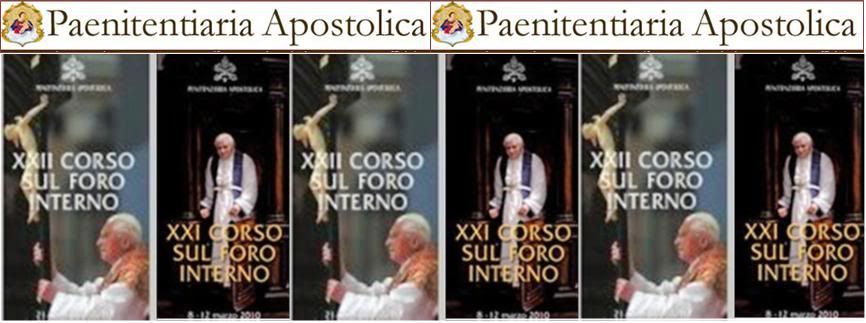 Pope Benedict XVI talks to priests
Pope Benedict XVI talks to priests
about the sacramental value of confession

March 25, 2011
Each year during Lent, the Apostolic Penitentiary holds a formation course on the so-called 'internal forum' – the personal area of conscience and judgment, which is of paramount importance for penitents and priest-confessors.
In his remarks on Friday to the more than 700 participants in this year’s course, Pope Benedict XVI concentrated on the pedagogical value of the sacrament of Christian penance – discussing the ways in which the sacrament can be and provide teaching moments for both priests and penitents, alike.
The Holy Father said, “In our time, characterized by noise, by distraction and by solitude, the colloquy of the penitent with the priest can represent one of the few – perhaps the only – occasion for truly being listened-to and heard in the depths of one’s being.”
The Holy Father also encouraged priests to spend time in the confessional. “Dear priests,” continued Pope Benedict, “do not neglect to give opportune space to the exercise of the ministry of the Sacrament of Penance,” which, he said, “educates the penitent in humility, in the recognition of his frailty, and the awareness of the need for God’s forgiveness and trust that God’s Grace can transform one’s life.”
The 2011 Lenten course of the Apostolic Penitentiary opened on Monday, March 21st, and ends today.
Here is a translation of the Holy Father's address:
Dear friends,
I am very happy to extend to each of you a most cordial welcome. I greet Cardinal Fortunato Baldelli, the Major Penitentiary, and thank him for his kind words.
And I greet Penitentiary Regent, Mons. Gianfranco Girotti, the staff, the co-workers and all the participants of this course on the internal forum, which has now become an annual tradition and an important occasion for examining in depth the Sacrament of Penance.
I wish to dwell today on an aspect that is often not sufficiently considered but which has great spiritual and pastoral relevance: the pedagogical or teaching value of sacramental confession.
While one must always be objective about the effects of the Sacrament and its correct celebration according to the norms of the Rite of Penitence, it is not out of place to reflect on how it could educate the faith, both of the minister and of the penitent.
The faithful and generous availability of priests to hear confessions, following the example of great saints like Jean Marie Vianney and John Bosco, of Josemaria Escriva de Balaguer and Padre Pio of Pietrelcina, of Giuseppe Cafasso and Leopoldo Mandic, can show us all how the confessional can be a true 'place' of sanctification.
In what way can the Sacrament of Penance educate? In what sense does its celebration have a pedagogical value especially for its ministers?
We can start from acknowledging that the priest's mission is a unique and privileged observation point, from which daily, we are given to contemplate the splendor of divine mercy.
How many times during the celebration of the Sacrament does the priest assist at a true and proper miracle of conversion which, by renewing "the encounter with an event, a Person" (Deus caritas est, 1), which reinforce his own faith!
Basically, to hear confessions means to witness as many
professiones fidei (professions of faith) as there are penitents, to contemplate the action of merciful God in history, to touch with one's hands the saving effects of the Cross and Resurrection of Christ.
Not rarely we are faced with true existential or spiritual tragedies which do not find a response in the words of men, but are embraced and assumed by Divine Love, which pardons and transforms: "Though your sins be like scarlet, they may become white as snow" (Is 1,18).
To know the human heart is in some way to visit its abyss, even its darkest aspects: If. on the one hand, it tests the humanity and faith of the priest himself, on the other hand, it nourishes in him the certainty that the last word on evil in man and in history is God's, and his mercy which is capable of renewing all things (cfr Ap 21,5).
How much priests can learn from penitents who are exemplary for their spiritual life, for the seriousness in which they conduct their examination of conscience, for their transparency in recognizing their own sins, and for their obedience to the teaching of the Church and their confessor's counsel!
In administering the Sacrament of Penance we can receive profound lessons of humility and faith. It is a very strong reminder for every priest to be conscious of his own identity.
Never, merely through the strength of our humanity, could we listen to our brothers' confessions! If they come to us, it is only because we are priests, who are configured to Christ the Eternal and Supreme Priest, and therefore able to act in his name and in his person, thus rendering truly present God who pardons, renews and transforms.
The celebration of the Sacrament of Penance has a pedagogical value for the priest, according to his faith, to truth, and to the poverty of his own person, and nourishes in him a consciousness of sacramental identity.
And what is the pedagogical value of the Sacrament of Penance to the penitents? We must presume that it depends, first of all, on the action of grace and the objective effects of the Sacrament on the soul of the faithful.
Certainly, sacramental reconciliation is one of the times when personal freedom and consciousness of oneself are called on to be expressed in a specially obvious way. Perhaps it is also because of this that in a time of relativism and the consequent attenuation of self-awareness, even sacramental practice has been weakened.
Examination of conscience has an important pedagogical value: It educates us to look sincerely at our own existence, to compare it against the truth of the Gospel, and to evaluate it not only with human criteria but with criteria that are drawn from divine revelation.
A confrontation with the Ten Commandments, with the Beatitudes, and above all, with the precept of love, constitutes the first great 'penitential school'.
In our day, which is characterized by noise, distraction and loneliness, the penitent's conversation with his confessor can represent one of the few occasions - if not the only one - for the priest to be truly heard and heeded profoundly.
Dear priests, do not neglect to give appropriate room for exercising the ministry of penance at the confessional: (For teh penitent), to be welcomed and heard is also a human sign of the welcoming goodness of God towards his children.
Further, An integral confession of sins educates the penitent in humility, to acknowledging his own frailty, and at the same time, to awareness of the need for God's forgiveness and for trusting that divine grace can transform his life.
Listening to the admonitions and counsel of the confessor is important for judgment on one's acts, for one's spiritual journey, and for the interior healing of the penitent. Let us not forget how many conversions and how many truly saintly lives began in the confessional!
Finally, the acceptance of penance and listening to the words "I absolve you of your sins" represent a true school of love and hope, which leads to full confidence in God-Love revealed in Jesus Christ, and to personal responsibility and commitment for continual conversion.
Dear priests, may our own experience of divine mercy, of which we are the humble instruments, educate us to an ever more faithful celebration of the Sacrament of Penance and to a profound gratitude to God who "has entrusted to us the ministry of reconciliation"
(1Cor 5,10).
To the Blessed Virgin Mary, Mater misericordiae and Refugium peccatorum - Mother of Mercy and refuge of sinners - I entrust the fruits of your course on the internal forum and the ministry of all confessors, as I bless you all affectionately.
[Modificato da TERESA BENEDETTA 25/03/2011 21:31] |
| |
 25/03/2011 21:15 25/03/2011 21:15 |
|
| | | OFFLINE | Post: 372
Post: 94 | Registrato il: 28/05/2007
Registrato il: 19/02/2009 | Utente Comunità | Utente Junior | |
|
Perfect description of Berlin. What an incredible place.
A city who has seen so many cultural battles, so many ideologies and philosopy, so much destruction and so much glory.
It's trying to mask its pained soul with good looks and culture.
Prussian rigor is the complete opposite of lively, baroque, Bavarian optimism.
It's not compatible at ALL.
*sigh*
Sweet dreams of independence....
 Dear Heike... Sorry for the delayed reply. I am glad you confirm Jose Luis Restan's perceptive insight about Berlin. Although I haven't been in Germany since 2001, I did feel he had a grasp of Berlin's particular history and culture... BTW, I just checked the KIRCHE 2011 site - they have not added more signatories to the 311 they had when I last looked two weeks ago. I think that's all they will get, and I don't think they got even HK to sign on. He has his own one-man 'crusade' (or lack of a better word) and won't play 'me-too' to anyone...
Dear Heike... Sorry for the delayed reply. I am glad you confirm Jose Luis Restan's perceptive insight about Berlin. Although I haven't been in Germany since 2001, I did feel he had a grasp of Berlin's particular history and culture... BTW, I just checked the KIRCHE 2011 site - they have not added more signatories to the 311 they had when I last looked two weeks ago. I think that's all they will get, and I don't think they got even HK to sign on. He has his own one-man 'crusade' (or lack of a better word) and won't play 'me-too' to anyone...
Did you read his far-out March 9 interview with FAZ? I actually found time to translate it before my laptop was attacked by a virus so the translation has been forcibly 'locked'. It will have its uses some day. One of the most interesting things in it is that he says celibacy has worked for him. So why does he think other priests or men who want to be priests would be any less able than he is to live a celibate life?... ACH!!!
TERESA
[Modificato da TERESA BENEDETTA 26/03/2011 14:34] |
| |
 25/03/2011 22:40 25/03/2011 22:40 |
|
| | | OFFLINE | | Post: 22.362
Post: 4.987 | Registrato il: 28/08/2005
Registrato il: 20/01/2009 | Administratore | Utente Master | |
|
 A couple of JON-2 reviews by two ecclesiastics, which I missed although they are posted on the Ignatius Press website for the book... Fr. Rosica wrote an earlier, longer review for ZENIT on the day the book came out (posted on P. 193 of this thread....
A biblical retreat on the Passion and
A couple of JON-2 reviews by two ecclesiastics, which I missed although they are posted on the Ignatius Press website for the book... Fr. Rosica wrote an earlier, longer review for ZENIT on the day the book came out (posted on P. 193 of this thread....
A biblical retreat on the Passion and
Resurrection narratives of the Gospels
By Fr. Thomas Rosica, C.S.B.
March 17, 2011
Fr. Rosica is the CEO of Canada’s Salt and Light Catholic Media Foundation.
Pope Benedict’s first book, Jesus of Nazareth: From the Baptism in the Jordan to the Transfiguration, was a masterpiece and model of authentic Scripture scholarship – the lived experience of' the praying and thinking Church, faith, piety and devotion all working together. I am very grateful to Ignatius Press for having invited me to read Pope Benedict XVI’s second manuscript: Jesus of Nazareth: Holy Week – From the Entrance into Jerusalem to the Resurrectionprior to its publication and presentation to the world by the Vatican Press Office on March 10, 2011.
As a student of Sacred Scripture, scholar and lecturer in New Testament, I spent two days reading the new, dense text of Pope Benedict XVI – Joseph Ratzinger – and came away from the experience as if I had been on a biblical retreat on the Passion and Resurrection Narratives of the Gospels – the very stories at the heart of the Christian faith.
Some of the very striking aspects of this book are when Pope Benedict moves from being exegete and professor to pastor and friend with his very personal additions.
One of those comes in the epilogue of the book on the Ascension of the Lord into heaven. Benedict writes:
After the multiplication of the loaves, the Lord makes the disciples get into the boat and go before him to Bethsaida on the opposite shore, while he himself dismisses the people. He then goes ‘up on the mountain’ to pray. So the disciples are alone in the boat. There is a headwind, and the lake is turbulent. They are threatened by the power of the waves and the storm.
The Lord seems to be far away in prayer on his mountain. But because he is with the Father, he sees them. And because he sees them, he comes to them across the water; he gets into the boat with them and makes it possible for them to continue to their destination...
In our own day, too, the boat of the Church travels against the headwind of history through the turbulent ocean of time. Often it looks as if it is bound to sink. But the Lord is there, and he comes at the right moment. ‘I go away, and I will come to you’ – that is the essence of Christian trust, the reason for our joy.
It is this personal encounter with the living Lord, traveling in the boat with us, that lies at the heart of Jesus of Nazareth by Pope Benedict XVI – Joseph Ratzinger.
This book should be required reading for every bishop, priest, pastoral minister and serious Catholic who would like to meet Jesus of Nazareth and deepen his/her knowledge of the very person of Jesus and the central mysteries of our faith. I could think of no better way to prepare for Holy Week and Easter this year than to read this text.
An extraordinary walk through
the passages of the Gospel
by Mons. Gerald M. Barbarito
Bishop of Palm Beach, Florida
March 11, 2011
Pope Benedict XVI’s second volume of Jesus of Nazareth truly is a concrete reflection on the word of God as revealed in the Gospels - particularly as it narrates the Passion of Christ through His Resurrection.
The Pope gives us an extraordinary walk through the passages of the Gospel which concentrates on this part of the Lord's mission in a manner that is both historically attuned and attuned to our faith. This is extremely significant for, as the Pope states in the preface of his work, it is during what we call Holy Week, that "we encounter the decisive sayings and events of Jesus's life.”
The manner of encountering the Gospels which the Pope uses in his work is to combine historical – critical exegesis with a hermeneutic of faith. To seek the historical Jesus, without reference to faith, makes it theologically irrelevant.
For the Pope, exegesis must be a historical and theological discipline. That is why he uses an exegesis that is very consistent with that of the Fathers of the Church.
Exegetical work, in the words of the Pope "must recognize that a properly developed faith - hermeneutic is appropriate to the text and can be combined with a historical hermeneutic, aware of its limits, so as to form a methodological whole.”
As he observes regarding the combination of these two hermeneutics, “Fundamentally this is a matter of finally putting into practice the methodological principles formulated for exegesis by the second Vatican Council (in Dei Verbum 12), a task that unfortunately has scarcely been attempted thus far." Simply put, we must read the words and the events of the life of Jesus in the context of faith!
It is inspiring to know that Pope Benedict XVI, despite his myriad responsibilities and obligations, found the writing of his personal work to be not only important for scholarly reflection but also personally renewing for him.
During whatever limited personal time he had, the Pope was committed to writing and finishing this personal work so that he might hand on in his personal and scholarly life the Person of Jesus Christ.
This is truly an example which speaks not one but many volumes of what the Pope means by fusing a hermeneutic of faith and historical criticism.
When we look to this book of the Holy Father we can also see the book of his life and that speaks of an encounter with Jesus Christ which continually unfolds for him for the service of the Church.
 And here's a review by an even higher-ranking ecclesiastic, though it is rather perfunctory, coming from someone like Cardinal Ravasi whose reputed intellectual prowess has John Allen lighting candles on his altar...
'Yes, there is still Christ'
And here's a review by an even higher-ranking ecclesiastic, though it is rather perfunctory, coming from someone like Cardinal Ravasi whose reputed intellectual prowess has John Allen lighting candles on his altar...
'Yes, there is still Christ'
A review of JON-2
by Cardinal Gianfranco Ravasi
President, Pontifical Council for Culture
Translated from

Issue for 3/30/11
“When I finished it, I wondered myself: Why ever Christ? But the more I examined it, the more carefully I looked, the more distinctly I saw Christ. I then noted on my diary – ‘Unfortunately, Christ is there. Unfortunately, there is still Christ’…” Thus, in the full swell of the Soviet Revolution, in 1918, Aleksandr Blok made this surprising confession about a poem 'The Twelve’ which he had just written.*
A symbol like the Crucifix still inspires ferocious polemic. There are those who would not acknowledge Christianity as the matrix of Western culture, but without the Gospels, a great part of Western art would be indecipherable.
And now a book like Benedict XVI’s Jesus of Nazareth is selling out in bookstores, and manages to feed new debates.
One can have a ‘different opinion‘ about the ultimate identity of Jesus, but there is no doubt that the ancient Simeon, holding the infant Jesus in his hands, defined him then as a ‘sign of contradiction’ - he is loved or detested, emblem of liberty or instrument of oppression, revolutionary or spiritual master, weak flesh and transcendent Logos, to use the language of the evangelist John.
Marco Pomilio, in the last lines of his novel Quinto evangelio (Fifth Gospel)(1975), goes back to a question that the rabbi of Nazareth once posed to his disciples: “Christ has held up the the mystery to our face, he has placed us in the situation of those disciples whom he asked, ‘And you, who do you say that I am?’”
So many and diverse are the answers, starting with the disciples then. Simplifying, we might say that the divergence is between those who see only a diaphanous Christ, immersed in divine light, and those who have only focused on the carnal Christ, who has historical attributes that are more or less decipherable.
The challenge of Benedict XVI’s JESUS OF NAZARETH is to recompose this scission, following the basic sources, namely the Gospels of Matthew, Mark, Luke and John.
The method he follows weaves the historical interpretation with the theological – namely he brings together the two ways open to us in order to isolate the ‘real’ Jesus Christ who is much more complex and complete than the simple ‘historical’ Jesus.
In fact, for every personality, and even for each of us, what is documentable in terms of unexceptionable historiography, is much less than each of us really is.
Of course, these are two different approaches, but ‘to distinguish the levels’, says the Pope, “does not mean separating them, nor contraposing them, nor merely juxtaposing them. They can only be treated in reciprocity."
To rediscover this interaction between history and faith – which is parallel to other relationships that have become common in historical research (think of the use of sociology, psychology, anthropology, etc) – responds to the intimate structure of the evangelical sources, as it does to a detailed analysis of existence: it is not fully decipherable only with physical or sociographical data but also through other forms of experience such as aesthetic, or mystical, or one of love.
Benedict XVI’s new book, continuing Volume I in 2007, focuses on the final events in the earthly life of Jesus: In nine stages, we go from the dramatic hours leading to his arrest and his double trial, first before the Sanhedrin, the supreme Jewish court, and then at the imperial Roman praetorium, to the supreme act of the crucifixion.
But the true peak is the Resurrection-Ascension which opens an unprecedented horizon in which the intersection between history and mystery reaches white heat.
Free of every literalism – “Ascension is not going towards a remote region of the cosmos, but it is the permanent nearness’ of Christ in the divine infinite that embraces and transcends space) – Christianity is presented here in all its power for provocation and for hope.
The atheist Emil Cioran was right when he lamented that in our time, “Christianity, consumed to the bone, has ceased to be a source of wonder and of scandal, it has stopped reining in vice and rendering intelligence and love more fruitful.”
[Ravasi somehow leaves his article dangling. In view of his last sentence, one would expect a statement saying how the Pope's book helps, if he thinks it does, to renew Christianity so that it can once again inspire wonder and make intelligence and love more fruitful!]
Here's my footnote about Blok:* [Ravasi brings up an intriguing poet and a most intriguing poem. If I had never heard of Blok or 'Twelve', I would have surely looked them up, but as it happens, I read two translations some time in the 1970s when Yevgeny Yevtushenko's work got me interested in Russian poetry, and I remember how powerful it was, how well-crafted, and that it read very well even in English.
Blok (1880-1921) was a famous Symbolist poet whose work inspired many emerging Russian writers like Anna Akhmatova, Vladimir Nabokov and Boris Pasternak in the first half of the 20th century. I've looked up the poem again. Without going into what the poem was intended to mean, other than an obvious metaphor for the dark, perilous and stormy unknown that follows a major revolution, 'Twelve', written in 12 cantos, tells about 12 Bolshevik Red Guards - raw recruits and ruffians - on patrol through the nighttime streets of St. Petersburg during a blizzard when the power is off. Perceiving someone ahead of them in the snow, they trail him through the stormy darkness as though he were leading them, and in the end he is revealed to be Jesus Christ in white, wearing a wreath of white roses and a bloody banner. This is the context for his diary entry.
The poem aroused controversy - the Bolsheviks attacked him for putting Christ in a revolutionary poem, conservatives accused him of blasphemy, and those in the middle said he was confused. He was not a religious man, and he told his critics he did not want the figure to be Christ - he thought Jesus was effeminate and unsatisfying - he wanted someone OTHER to 'lead', but that his creative will told him it had to be Jesus. He died three years later, having become disillusioned with the Russian Revolution soon after he published 'Twelve'.]
[Modificato da TERESA BENEDETTA 26/03/2011 03:55] |
| |
 26/03/2011 00:17 26/03/2011 00:17 |
|
| | | OFFLINE | | Post: 22.363
Post: 4.988 | Registrato il: 28/08/2005
Registrato il: 20/01/2009 | Administratore | Utente Master | |
|
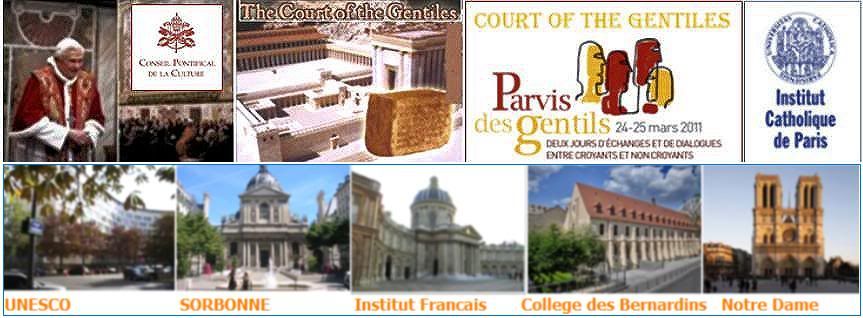 I am still frustrated and hampered by the lack of interest so far in the Anglophone media (exceot for Reuters wehose religion corrrespondent is based in Paris) for the Court of the Gentiles launch, despite the many events, their exceptional venues and the participation of exceptional personalities in this event. But I cannot fault the Amglophone media too much because even Agence France Presse's (AFP) 'France 24' round-the-clock online service does not have a single line about it so far in either its French or its English services.
I am still frustrated and hampered by the lack of interest so far in the Anglophone media (exceot for Reuters wehose religion corrrespondent is based in Paris) for the Court of the Gentiles launch, despite the many events, their exceptional venues and the participation of exceptional personalities in this event. But I cannot fault the Amglophone media too much because even Agence France Presse's (AFP) 'France 24' round-the-clock online service does not have a single line about it so far in either its French or its English services.
Vatican Radio at least has promptly provided an English rtanslation of the Holy Father's video message beamed Friday night to an assembly of young people in the vast square in front of the Notre Dame Cathedral, though without any report on the event itself. For now, here is the Pope's beautiful message tonight....
For believers and non-believers
to rediscover the path of dialogue:
The Holy Father's video-message

March 25, 2011
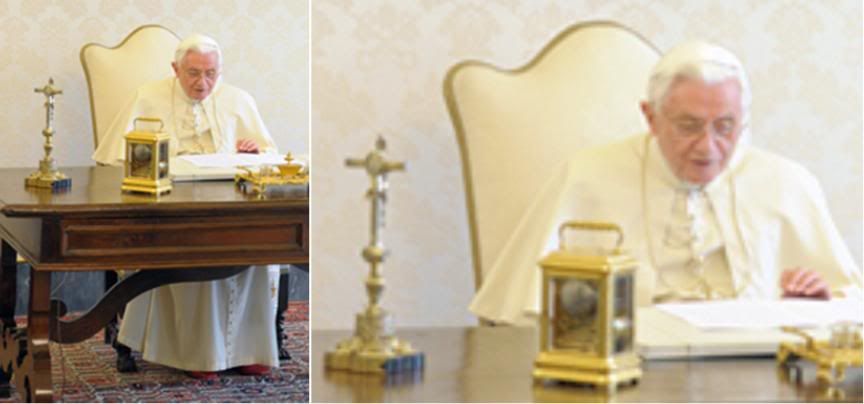 Dear young people, dear friends!
Dear young people, dear friends!
I know that at the invitation of Cardinal André Vingt-Trois, the Archbishop of Paris, and of Cardinal Gianfranco Ravasi, the President of the Pontifical Council for Culture, you are gathered in great numbers in front of the Cathedral of Notre Dame in Paris. I greet all of you, together with our brothers and friends from the Taizé Community.
I am grateful to the Pontifical Council for having taken up and extended my invitation to open a number of “Courts of the Gentiles” within the Church.
This image refers to the vast open space near the Temple of Jerusalem where all those who did not share the faith of Israel could approach the Temple and ask questions about religion. There they could meet the scribes, speak of faith and even pray to the unknown God.
The Court was then an area of separation, since Gentiles did not have the right to enter the consecrated area, yet Jesus Christ came to “break down the dividing wall” between Jews and Gentiles, and to “reconcile both to God in one body through the cross, thus putting to death that hostility in himself”. In the words of Saint Paul, “He came and proclaimed peace...” (cf. Eph 2:14-17).
At the heart of the City of Light, in front of the magnificent masterwork of French religious culture which is Notre Dame, a great court has been created in order to give fresh impetus to respectful and friendly encounter between people of differing convictions.
You young people, believers and non-believers alike, have chosen to come together this evening, as you do in your daily lives, in order to meet one another and to discuss the great questions of human existence.
Nowadays many people acknowledge that they are not part of any religion, yet they long for a new world, a world that is freer, more just and united, more peaceful and happy. In speaking to you tonight, I think of all the things you have to say to each other.
Those of you who are non-believers challenge believers in a particular way to live in a way consistent with the faith they profess and by your rejection of any distortion of religion which would make it unworthy of man.
Those of you who are believers long to tell your friends that the treasure dwelling within you is meant to be shared, it raises questions, it calls for reflection. The question of God is not a menace to society, it does not threaten a truly human life! The question of God must not be absent from the other great questions of our time.
Dear friends, you are challenged to build bridges between one another. Take advantage of this opportunity to discover, deep within your hearts and with serious arguments, the ways which lead to profound dialogue. You have so much to say to one another! Do not turn away from the challenges and issues before you!
I believe deeply that the encounter of faith and reason enables us to find ourselves. But all too often reason falters in the face of self-interest and the lure of profit, and is forced to regard the latter as the ultimate criterion.
Striving for truth is not easy. But each of us is called to make a courageous decision to seek the truth, precisely because there can be no shortcut to the happiness and beauty of a life of genuine fulfilment. Jesus says as much in the Gospel: “The truth will make you free”.
Dear young people, it is up to you, in your own countries and in Europe as a whole, to help believers and non-believers to rediscover the path of dialogue.
Religions have nothing to Fear from a just secularity, one that is open and allows individuals to live in accordance with what they believe in their own consciences.
If we are to build a world of liberty, equality and fraternity, then believers and non-believers must feel free to be just that, equal in their right to live as individuals and in community in accord with their convictions; and fraternal in their relations with one another.
One of the reasons for this Court of the Gentiles is to encourage such feelings of fraternity, over and above our individual convictions yet not denying our differences. And on an even deeper level, to recognize that God alone, in Christ, grants us inner freedom and the possibility of truly encountering one another as brothers and sisters.
Our first step, the first thing we can do together, is to respect, help and love each and every human being, because he or she is a creature of God and in some way the road that leads to God.
As you carry on the experience of this evening, work to break down the barriers of fear of others, of strangers, of those who are different; this fear is often born of mutual ignorance, scepticism or indifference.
Work to create bonds with other young people, without distinction and keeping in mind those who are poor or lonely, unemployed, ill or on the margins of society.
Dear young people, what you can share is not only your experience of life, but also your approach to prayer. Believers and non-believers, as you stand in this court of the Unknown, you are also invited to approach the sacred space, to pass through the magnificent portal of Notre Dame and to enter the cathedral for a moment of prayer.
For some of you this will be a prayer to a God you already know by faith, but for others it may be a prayer to the Unknown God. Dear young friends who are non-believers, as you join those who pray in Notre Dame on this day of the Annunciation of the Lord, open your hearts to the sacred texts, let yourselves be challenged by the beauty of the music and, if you truly desire it, let your deepest feelings rise towards the Unknown God.
I am happy to have been able to speak to you this evening for the inauguration of the Court of the Gentiles. I hope you will be able to join me for the other events to which I have invited you, especially the World Youth Day to be held in Madrid this coming summer.
The God whom believers learn to know invites you to discover him and to find ever greater life in him. Do not be afraid! As you walk together towards a new world, seek the Absolute, seek God, even if for you he is the Unknown God.
And may this God, who loves each and every one of you, bless you and keep you. He is counting on you to be concerned for others and for the future, and you can always count on him!
OK, I have now found one other English report on this story, but rather brief, and obviously written before the text of teh Pope's videomessage was released:
Vatican launches platform
for dialogue with atheists
By Francis X. Rocca

VATICAN CITY, March 25 (RNS) -- A new Vatican initiative to promote dialogue between believers and atheists debuted with a two-day event on Thursday and Friday in Paris.
“Religion, Light and Common Reason” was the theme of seminars sponsored by the Vatican’s Pontifical Council for Culture at various locations in the French capital, including Paris-Sorbonne University and the United Nations Educational, Scientific and Cultural Organization (UNESCO). [He left out the Institut Francais, home of teh Academie Francaise, France's most prestigious intellectual isntitution.]
“The Church does not see itself as an island cut off from the world. ... Dialogue is thus a question of principle for her,” Cardinal Gianfranco Ravasi told the French newspaper La Croix. “We are aware that the great challenge is not atheism but indifference, which is much more dangerous.”
The events were scheduled to conclude with a party for youth in the courtyard of the Cathedral of Notre Dame on Friday evening, featuring an appearance via video by Pope Benedict XVI, followed by prayer and meditation inside the cathedral.
The initiative, called “Courtyard of the Gentiles,” takes its name from a section of the ancient Temple of Jerusalem accessible to non-Jews, which Benedict has used as a metaphor for dialogue between Catholics and non-believers.
[Modificato da TERESA BENEDETTA 26/03/2011 20:29] |
| |
 26/03/2011 13:02 26/03/2011 13:02 |
|
| | | OFFLINE | | Post: 22.364
Post: 4.989 | Registrato il: 28/08/2005
Registrato il: 20/01/2009 | Administratore | Utente Master | |
|
 In the face of Promethean/Sisyphean weakness,
In the face of Promethean/Sisyphean weakness,
criticism of contemporary relativism in JON-2:
Excerpts from the presentation of
Mons. Gerhard Ludwig Mueller
Bishop of Regensburg
Translated from the 3/24/11 issue of
 Editor's Note: Here are excerpts from the lecture given by the Bishop of Regensburg at the presentation Thursday night of JESUS OF NAZARETH Vol II at the Basilica of St. John Lateran in the 'Dialoghi nella Cattedrale' series presented by the Diocese of Rome.
Editor's Note: Here are excerpts from the lecture given by the Bishop of Regensburg at the presentation Thursday night of JESUS OF NAZARETH Vol II at the Basilica of St. John Lateran in the 'Dialoghi nella Cattedrale' series presented by the Diocese of Rome.
In the sixth year of the Pontificate of His Holiness Benedict XVI, the second of his three volumes dedicated to the figure of Jesus has been published. The first part of the trilogy was dedicated to the period "from the baptism on the Jordan to the Transfiguration'. and teh second one which came out earlier this month, is subtitled "From the entry into Jerusalem to the Resurrection".
In nine chapters, the Holy Father elaborates the great scenes of the Passion of Christ. These are key scenes to understand the person of Jesus and his mission: Who is Jesus with respect to God his Father? And what does he mean to us?
The author reflects and explains in detail the sense and the significance of the entry into Jerusalem and of the purification of the Temple; followed by the eschatological discourse on the end of the Temple and the advent of the pagan era; the washing of the feet; the priestly prayer; the Last Supper with the institution of the Eucharist, as the central sacrament of the Church; the trial of Jesus; his crucifixion, the deposition in the tomb and his subsequent resurrection; and finally, an analysis of the pronouncement in the Credo: "He ascended into heaven, seated at the right hand of the Father, and he will come again in glory".
It is an imposing work of admirable commitment, which the Pope wished to assume alongside his already enormous incumbencies and responsibilities for the universal Church - and despite his venerable age.
Some may ask whether the Pontiff would have done better to leave a work of strictly scientific character in the hands of professors of exegesis and history who are much younger and, according to them, more competent.
Shouldn't he better face far more important tasks at a time when the boat of Peter is at the mercy of growing tides of secularism and when, in order to deal with the increasingly violent anti-clerical waves, the Church needs all of the attention of its helmsman?
To such objections, I counter: Is it not precisely the task of St. Peter to call general attention to the only one who is able to arrest wind and wave, and to bring the boat of his Church to the secure port of eternity?
To make the figure of Jesus accessible to men who are at risk of being carried away by the tempests of time and history, is undoubtedly an undertaking that goes far beyond the passion of an ex-professor of theology whose preferred occupation is writing books.
Because this is not just one more book about Jesus. That the entire world would not suffice to contain all the books that one could write about Jesus was already apparent to the evangelist St. John in the first century (cfr Jn 21,22).
Instead, the Pope has concerned himself directly with Jesus, and through him, our relationship with God.
Despite the enormous importance of the Bible in the life of the Church, Christianity is not a religion of the book. Christian faith is an encounter with a person. And the totally unique thing about Jesus is that by getting close to him, I am dealing with God himself. At the same time, I know that I am perfectly understood and sustained by him in my own existential affairs, in my sufferings, hopes and fears.
Jesus is decisive for the success or failure of my life. Jesus is true God, the Son in the trinitarian communion of Father, Son and Holy Spirit. But Jesus is also, through the Incarnation of the divine Word, a man like me, up to the death that he suffered on the cross to guarantee to us the prospect of eternal life.
In the Gospel of John, it is stressed that the book was not written as a historical biography to inform us, with the aid of sociology and psychology, about the life and destiny of a historical personage, but rather "so that you may believe that Jesus is the Christ, Son of God, and because, by believing, you may have eternal life in his name" (Jn 20,31).
Thus, even Pope Benedict XVI, in an era of growing doubts, of uncertainties on how to transmit the faith in a Europe that is so profoundly confused over its own Christian identity - without a measuring standard or a goal, without an origin or a future, in a situation of the general crisis of mankind - has also written this book so that men may orient themselves anew towards Jesus.
Because only an orientation towards God-Man can save us, not becoming hardened in an ideology, in a mental construction with a human matrix, in a pax sovietica, pax americana or pax cinese, what have you, or a model of society that is purely economic and scientific.
Indeed, however valuable the human intellect is, and however fides et ratio, like a couple of lovers, can be of no use to each other in a theory and practice of a world cut off from knowing God - with philosophy and ethics alone, we can never reach an absolute knowledge of the reality of the world and of man, nor lift ourselves enough to be our own redeemers.
Fundamentalism and relativism are the twin brothers of subjectivism - faith as opinion or discretional decision of the subject - while the Christian profession is based on reality established by God himself, by the Son of God who became man; "There is no salvation through anyone else, nor is there any other name under heaven given to the human race by which we are to be saved" (Acts 4,12).
Christianity is substantially and essentially a relationship between persons, not between a person and an idea or a moral law, or the objective spirit of law, or science, religion, culture and philosophy.
Faith is the relationship of man with Jesus, and through him, with God, and as such, is a communion of life with God and a communion of life with all those who belong to him in the Church, as a communion of faith, hope and charity.
My personality develops in relationship to my parents, my brothers and sisters, friends and teachers, and not to the idea of genitoriality, to the functional plane of teaching, to the structures of the educational system or the academic-university system. The relationship between persons is always preeminent with respect to the material sphere or factual elements, and this avoids that man 'loses his own soul'.
As pastor of souls, the Holy Father wishes to encourage the doubters and reinforce all his brothers and sisters in their faith (cfr Luke 22,32). In fact, we can, with tranquillity, subject the Christian faith, Biblical witness, and the entire apostolic tradition and magisterium of the Catholic Church to the thorniest interrogation in history and to philosophical skepticism.
This decantation by the Enlightenment and criticism of religion has highlighted in a more manifest and convincing manner that our faith is due to the real self-revelation of God and that our relationship with Jesus rests on a firm historical foundation.
Critical philosophy and historico-critical methodology in Biblical exegesis, placed at the service of the science of faith, can confirm the historicity of Revelation and the reliability of the Gospels as the testimony of persons and of the story of Jesus, if they accept liberating themselves from the unfounded and a priori conviction that man is incapable of transcending his humanity.
Our relationship with Jesus is a relationship of acknowledging his person under the sign of love: love not understood, obviously, as mere sentiment alongside a rational confrontation with historical sources.
Love in this case means accepting any other person without reservation and to experience at the same time that the other acknowledges and accepts us perfectly. Even now Jesus remains for many persons a model in the moral and humanitarian sense, and many identify themselves with him.
But this unilateral identification with another does not yet signify friendship and love. It could still be simple narcissism, if I limit myself to instrumentalizing the other as a model for myself. In theological terms: Jesus is for us not just an exemplum, he is also donum.
He gives himself to me as a divine presence in my heart and in my existential affairs and in the entire history of mankind. We live in God to the degree that he lives in us. Thus the encounter of love with Jesus is redemption and God's Shalom, not just because I as a a creature seek to identify myself with God, but because God identifies himself with his creature, and he loved us even when we were sinners (1Jn 4, 10-16).
The risen Lord asks Peter, "Do you love me more than the others?" And three times Peter, acknowledging with full remorse his own betrayal of Jesus, responds, "You know that I love you". And Jesus entrusts his lambs and his sheep to him (cfr Jn 21m15-19).
It is therefore supremely opportune that today, in Rome, glorious site of his martyrdom, Peter, together with Paul, gives witness anew of our desire to glorify God, working for his Kingdom unto death.
The Successor of Peter, despite his advanced age, took on the labor on a trilogy which will amount to about a thousand pages, so that we may recognize the glory and freedom of children of God who, in Jesus, gave himself to us to a degree that transcends every human dimension, and so that we can identify the meaning of our life in Jesus's exhortation to follow him.
Neither Prometheus-Hegel nor Sisyphus-Marx have been able to subject the world to the power of man. Their interpretations of history and of man cannot determine nor modify our life, because they have failed to recognize man in his being. Being is indisposable, and this goes back to God as the origin of a love that enlarges itself without limitations and without ever claiming anything in return: "You were ransomed from your futile conduct, handed on by your ancestors, not with perishable things like silver or gold but with the precious blood of Christ as of a spotless unblemished lamb" (1Pt 18-19).
But the Savior and Redeemer does not make his apparition on the pages of the daily newspapers' cultural supplements and in consumerism with all its superficiality. All of man's attempts at self-redemption without cost are rooted in an abyss of crime and violence, spiritual emptiness and mortal tedium. The rejection of a God who acts in history and gives his revelation to man inevitably leads to the desperation of having to remain unredeemed.
The will for salvation is manifested and becomes reality only in the kenosia [emptying himself] of the Son of God (Phil 2,5-11) for he]im who trusts with faith and love in the person of the Son sent by the Father to become man.
To face the apparently invincible Goliath of relativism - intellectually and politically made militant and potentiated by the media - David, shepherd of the People of God, forges ahead, without weapons but full of imperturbable truct in God "in the name of the Lord' (1 Sam 17,45).
The language and the reasoning of Benedict XVI have a simple and modest tone, like Paul's. It is not about assering himself in brilliant discourses, nor abandoning himself to the intellectual pleasure of reflection, but of disseminating the announcement of God.
Our respect for a mankind that is vacillating, skeptical, agnostic, disillusioned, is modelled after the love with which Jesus looked at the young man who asked him what he had to do to obtain eternal life (cfr Mt 19,16).
And Paul suggests to witnesses and preachers of the Gospel the method for their mission: "My message and my proclamation were not with persuasive (words of) wisdom, but with a demonstration of spirit and power, so that your faith might rest not on human wisdom but on the power of God" (1Cor 4,ff).
It has been customary to categorize the attitude of young people, but even of intellectuals in the Christiasn coutnries of Europe, into problem and crisis. In broad terms, this is a precise valuation. Notwithstanding, we continue to see the miracle of young people who emerge undamaged from the omnipotent mainstreaming of anti-Christian idolatry and, perfectly lucid in mind and with hearts full of love, ask, "Show us Jesus".
Indeed, all of us must ask ourselves what we think of the Son of man. "You are Christ, son of the living God", Peter professed (Mt 16,16). In Peter, not only the mission of the evangelical announcement has been transferred to the Church, but he assures that to the end of time, he will firmly resist all the pressing attacks from the gates of hell.
Let us thank the Holy Father tonight for his book. It is a testimonial rendered to Jesus, author and perfector of our faith (Heb 12,2). whom we shall greet anew with jubilation this Easter.
[Modificato da TERESA BENEDETTA 27/03/2011 00:29] |
| |
 26/03/2011 14:15 26/03/2011 14:15 |
|
| | | OFFLINE | | Post: 22.365
Post: 4.990 | Registrato il: 28/08/2005
Registrato il: 20/01/2009 | Administratore | Utente Master | |
|
 Saturday, March 26, Second Week in Lent
Saturday, March 26, Second Week in Lent
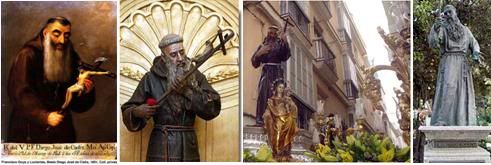 Second from right: San Diego Jose's image borne in a feastday procession in Cadiz.
BLESSED DIEGO JOSE (Didacus Joseph) OF CADIZ (Spain 1743-1801)
Second from right: San Diego Jose's image borne in a feastday procession in Cadiz.
BLESSED DIEGO JOSE (Didacus Joseph) OF CADIZ (Spain 1743-1801)
Capuchin, Preacher and Mystic, Apostle of the Trinity
As a Capuchin, Joseph was assigned to preach, which he did all over Andalusia (southern Spain),
very effectively. His reputation was such that persons listening to his sermons would seek to tear
off pieces of his habit to keep as a relic. Legend says that on occasion, he was seen to levitate
while preaching. The most famous story is that a child, seeing a dove perched on the priest's shoulder
while he was preaching on the Trinity said, "I could preach that well, too, if I had a dove telling me what
to say!" Although he was unlearned, his wisdom and reputation led him to be named external consultor
and synodal examiner in almost all the dioceses of Spain, as well as honorary doctorates from several
universities. His sermons were later published in 8 volumes, along with various letters he wrote on
significant events in the Church. He was beatified in 1894 and is greatly venerated in Spain,
particularly in his home city.
Readings for today's Mass: www.usccb.org/nab/readings/032611.shtml
OR today.
 This issue reports on the Pope's two audiences yesterday - with the Siro-Malankar bishops of India, and with 700 priests who took part in this year's course at the Apostolic Penitentiary on the examination of conscience before confession. Page 1 international news: Compromise allows NATO to take control of 'no-fly zone' military action against Libya, but questions about Libya's immediate future; more alarm now on failure to contain damage in Japan's Fukushima nuclear plant, as radioactive contamination becomes more widespread; In he inside pages, China's 2011-2015 economic plan aims for a more ecology-responsible economy; the president of Italy's Jewish communities welcomes a draft law in the Italian parliament that would penalize negationism of the Holocaust; and Christians in Spain and Latin America plan massive pro-life marches today and tomorrow to mark the World Day for Life.
AT THE VATICAN TODAY
This issue reports on the Pope's two audiences yesterday - with the Siro-Malankar bishops of India, and with 700 priests who took part in this year's course at the Apostolic Penitentiary on the examination of conscience before confession. Page 1 international news: Compromise allows NATO to take control of 'no-fly zone' military action against Libya, but questions about Libya's immediate future; more alarm now on failure to contain damage in Japan's Fukushima nuclear plant, as radioactive contamination becomes more widespread; In he inside pages, China's 2011-2015 economic plan aims for a more ecology-responsible economy; the president of Italy's Jewish communities welcomes a draft law in the Italian parliament that would penalize negationism of the Holocaust; and Christians in Spain and Latin America plan massive pro-life marches today and tomorrow to mark the World Day for Life.
AT THE VATICAN TODAY
The Holy Father met today with
- Cardinal Ivan Dias, Prefect of the Congregation for the Evangelization of Peoples (regular meeting)
- Four more Siro-Malnkar bishops from India (Group 3) on ad limina visit. Individual meetings.
- Pilgrims from the Diocese of Terni-Narni-Amelia (Italy). Address in Italian.
The Vatican also said that yesterday, the Pope met with Bishop Gerhard Mueller of Regensburg
who was in Rome to present the Pope's new book at a Lateran event Thursday night.
This time last year...
The New York Times launched its scurrilous story accusing Cardinal Ratzinger of having failed to discipline a Milwaukee priest who committed hundreds of sex abuses against deaf children in his care in the 1960s and 1970s, and whom the diocese forced into retirement in 1972. When the diocese decided to place him on canonical trial in 1996, more than 20 years later, the CDF through its then-secretary, Mons Tarcisio Bertone, approved the canonical trial but also mentioned the priest's request to be spared the trial because the charges had been previously investigated by the police before his retirement and were found not to be sustainable, and also because he was dying. In fact he died two months after Bertone's letter to the diocese.
The hue and cry falsely raised by the Times was particularly and deliberately malicious because all this happened before the CDF was given specific jurisdiction over sex abuses, and because the diocese never informed the CDF about the case until 24 years after the priest's retirement. It was made even more outrageous because the facts themselves from the documents that the Times posted online clearly contradicted the narrative put forward by their news report. (The Times actually believed no one would bother to check out the documents they posted so ostentatiously to 'prove' their good faith - in a shameless act of bad faith!)
The day after they broke the Milwaukee story, the Times followed with a report from Munich alleging that Cardinal Ratzinger, as Archbishop of Munich-Freising had in fact known that a priest from another diocese who was undergoing therapy in Munich for sexual misconduct was given a pastoral assignment not long after he got to Munich in 1991. The cardinal's Munich vicar at the time had previously stated he alone had been responsible for making the assignment.
Despite the hue and cry over both stories, they both proved to be fleeting media sensations, collapsing into dust from the weight of truth against their trial by innuendo.
[Modificato da TERESA BENEDETTA 26/03/2011 14:17] |
| |
 26/03/2011 16:20 26/03/2011 16:20 |
|
| | | OFFLINE | | Post: 22.366
Post: 4.991 | Registrato il: 28/08/2005
Registrato il: 20/01/2009 | Administratore | Utente Master | |
|
 Pope stresses importance
Pope stresses importance
of safety in workplace

March 26, 2011
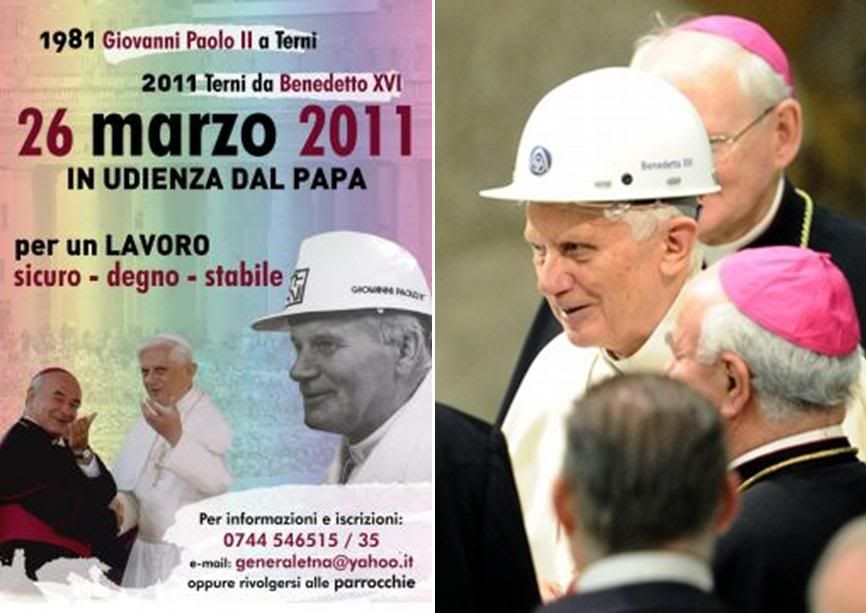 Diocesan poster for the pilgrimage; right, B16 adds a hardhat from the Terni steelworkers to his collection of headgear. Diocesan poster for the pilgrimage; right, B16 adds a hardhat from the Terni steelworkers to his collection of headgear.
Pope Benedict XVI on Saturday addressed pilgrims of Italy’s diocese of Terni-Narni-Amelia to commemorate the 30th anniversary of Pope John Paul II’s visit to the “Steel City”.
The southern Umbrian town of Terni is home to Italy’s first steel plant which was visited by Pope John Paul II on March 19th 1981: St. Joseph’s Day.
Speaking to pilgrims in the Paul VI Audience Hall, the Holy Father recalled how the late Pope presented himself at the plant as a “humble worker in the Lord’s vineyard” and reminded all workers to trust in the protection of St Joseph.
Pope Benedict went on to discuss how the current economic crisis is putting stress on the city, its workers and their families. He reiterated the words of Terni’s bishop, Monsignor Vincenzo Paglia, saying that in times of hardship, one should turn to the Sunday Eucharist as a source of joy, faith and passion to improve the world
Work, the Pope said, helps us be closer to God and to others.
The Holy Father also spoke about the importance of safety in the workplace, saying that every measure should be taken to avoid accidents and preventable deaths.
In his concluding remarks, the Pope said the Church encourages all efforts towards safe, dignified and stable work, and expressed his closeness to the families of Terni.
NB: The diocesan site says a record 8,000 pilgrims joined this year's pilgrimage to Rome. Similar visits were made by the diocese earlier to Benedict XVI in 2005 and 2007.
 The patron saint of Terni is San Valentino, the bishop-martyr executed in Rome in the third century, and who is most associated with the feastday of several saints named Valentino on February 14, date of the bishop's martyrdom in 273.
The patron saint of Terni is San Valentino, the bishop-martyr executed in Rome in the third century, and who is most associated with the feastday of several saints named Valentino on February 14, date of the bishop's martyrdom in 273.
Valentino, born around 176 had been consecrated Bishop of Terni when he was only 21. In 270, he went to Rome on the invitation of the philosopher Crato who wanted him to preach the Gospel. His activity earned him martyrdom under Aurelian, who had him decapitated.
Tradition says his remains were brought to Terni by three disciples who buried him on a hill, where a church was built in his honor as early as the 4th century. In the 7th century, excavations on the hill yielded a sarcophagus with remains that were recognized to be those of the martyr, and a basilica was built on the spot.
The removal of Valentine from the list of saints commemorated universally by the Church in 1969 (because of doubts and confusion about the basic facts of their lives) has obviously not affected the local devotion to him. In view of his subsequent worldwide fame as 'patron of lovers', the diocese and the basilica have incorporated hearts into their sites about the saint and his church.
The diocesan gift to the Pope today was an icon of San Valentino./DIM]
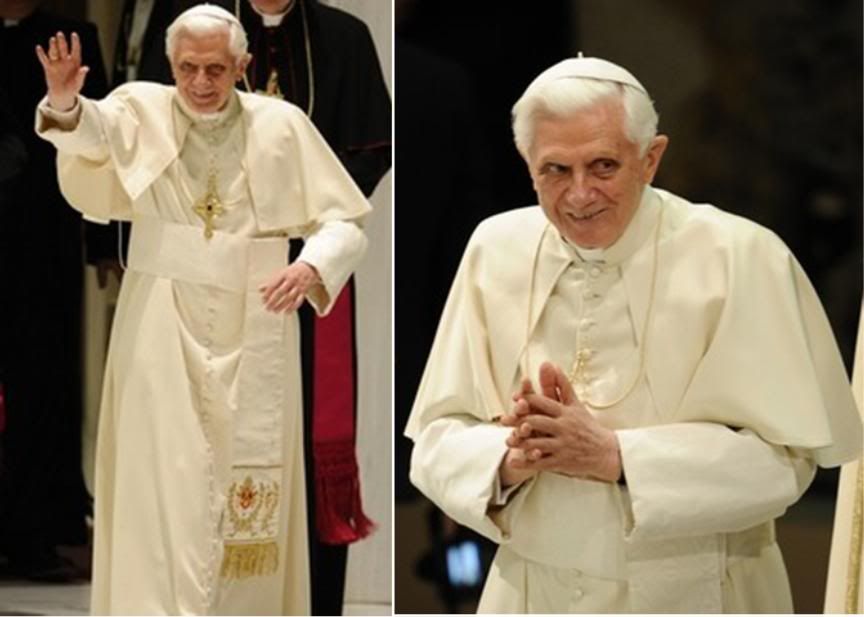
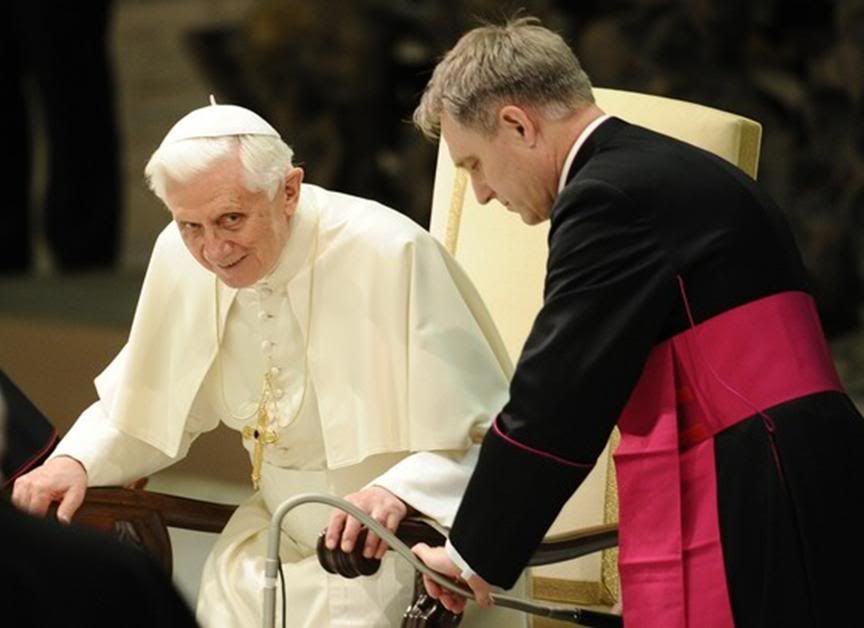
Here is a translation of the Holy Father's words to the pilgrims:
Dear brothers and sisters,
I am very happy to welcome you this morning and to extend my greetings to the authorities present, to the workers, and all of you who have come as pilgrims to Peter's See.
A special greeting to your bishop, Mons. Vincenzo Paglia, whom I thank for the words he addressed to me in you e behalf.
You have come in a great number to this meeting - and I am sorry that some have not been able to be accommodated here inside - on the occasion of the 30th anniversary of John Paul II's visit to Terni.
Today, we remember him especially for the love that he had for the world of labor. We can almost hear him repeat the first words which he said upon arriving in Terni 30 years ago: "The principal purpose of this visit - which takes place on the feast day of St. Joseph - is to bring a word of encouragement to all workers and to express my solidarity with them, my friendship, and my affection" (Address to authorities, Terni, March 19, 1981).
I make those sentiments mine, and in my heart, I embrace all of you and your families. On the day I was elected, I, too, presented myself with conviction as a 'humble worker in the vineyard of the Lord", and today, together with you, I wish to remind all workers to entrust themselves to the protection of St. Joseph the worker.
Terni is distinguished by the presence of one of the largest steel industries in Italy, which has contributed to the growth of significant workers' reality. It has been an experience marked by good times, but also by difficult moments as those we are living through these days.
The crisis of the industrial sector has been a difficult trial for the life of your city, which now has to rethink its future. And all this concerns your life as workers and that of your families. In the words of your bishop, I heard the echo of the concerns that you carry in your hearts.
I know that the diocesan Church makes them her concerns and feels the responsibility of being close to you in order to communicate the hope that is in the Gospel and the strength to build a society that is more just and more worthy of man.
And this is done by starting from the source, from the Eucharist. In his first pastoral letter entitled 'The Eucharist saves the world', your bishop has indicated to you this spring from which to draw and to which to return always, in order to live the joy of the faith and the passion for making the world a better place.
Thus, the Sunday Eucharist has become the fulcrum of the diocese's pastoral activity. It is a choice that has already borne fruit: participation in Sunday Mass has grown, and from this, the diocese draws a greater commitment for the course your land will take.
Indeed, from the Eucharist, in which Christ makes himself present in his supreme act of love for all of us, we learn to live as Christians in society, to make it more welcoming, more fraternal, more attentive to the needs of everyone, especially the weakest, more rich in love.
St. Ignatius of Antioch, bishop and martyr, defined Christians as those 'who live according to Sunday' (iuxta domenicum viventes), namely, those who live according to the Eucharist.
To live in a eucharistic way means to live as one Body, one family, a society held together by love. The exhortation to be 'eucharistic' is not a simple moral invitation addressed to single individuals, but is so much more: it is an exhortation to participate in the dynamism of Jesus himself who offers his life for others so that all may be one.
The subject of work that so preoccupies you now, with all its problems, especially that of unemployment, fits into this context. It is important to keep in mind that work is one of the fundamental elements of the human being as well as of society.
The difficult or precarious conditions of work make the conditions of society itself difficult and precarious, those conditions necesssaary for an life ordered according to the demands of the common good.
In the encyclical Caritas in veritate - as Mons. Paglia recalled - I exhorted not to stop 'pursuing as a priority the objective of access to work for all and keeping it" (No. 32).
I also wish to bring up the problem of safety at work. I know that you have had to face this tragic reality many times. Every effort must be made to break the chain of deaths and work accidents.
And what can we say about the uncertainty of work, especially for the younger people? It is something that creates anguish in many families.
Your bishop has also referred to be difficult situation of the chemical industry in your city, as well as in the steel industry itself.
I feel particularly close to you, and place in God's hands all of your anxieties and concerns, with the wish that, through the logic of free giving and of solidarity, you may overcome these difficulties and be assured of work that is safe, dignified and stable.
Work, dear friends, can help us be closer to God and to others. Jesus himself was a laborer - indeed, he spent most of his earthly life in Nazareth, working in Joseph's carpentry shop. The evangelist Matthew records that the people of Nazareth spoke of Jesus as 'the carpenter's son' (Mt 13,55), and John Paul II in Terni spoke of the 'gospel of work', saying "it had been written, above all, because of the fact that the Son of God, in becoming man, worked with his hands. Indeed, his work, which was actual physical labor, occupied the greater part of his life on this earth, before he entered into the work of redeeming man and the world" (Address to laborers, Terni, March 19, 1981).
This in itself speaks to us of the dignity of labor, the specific dignity of human labor which played a role in the mystery of redemption. It is important to understand it in this Christian perspective.
Often, however, it is merely seen as an instrument for profit, if not, as in many parts of the world, as a means of exploitation that is an offense to human dignity itself.
I wish to speak, too, about the problem of working on Sundays. Unfortunately, in our society, the rhythm of consumption threatens to rob us of the sense of holiday and of Sunday as the day for the Lord and for the community.
Dear workers, dear friends, I wish to end my brief remarks by telling you that the Church supports, comforts and encourages every direct effort to guarantee work that is safe, dignified and stable for everyone.
The Pope is close to you, to your families, your children, your young people and your aged, and in his heart he takes you all before God.
May the Lord bless you, your work and your future. Thank you.
The Pope gets a hardhat
and a football jersey
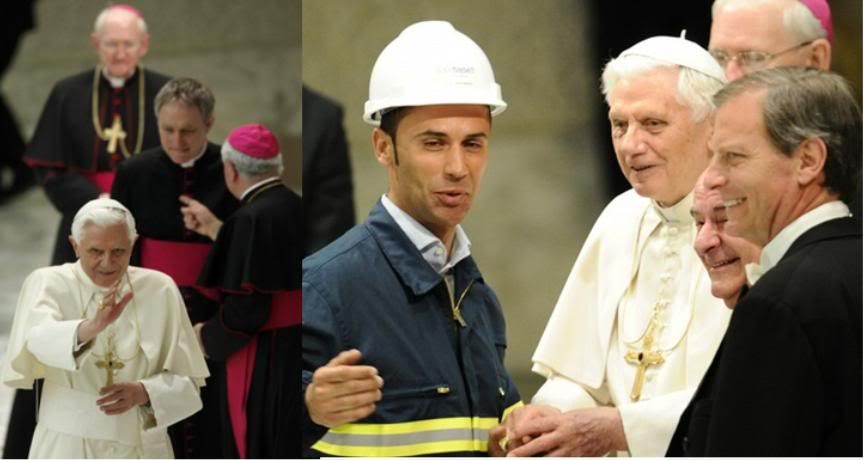

Apparently, the first hat was merely to try out for size:
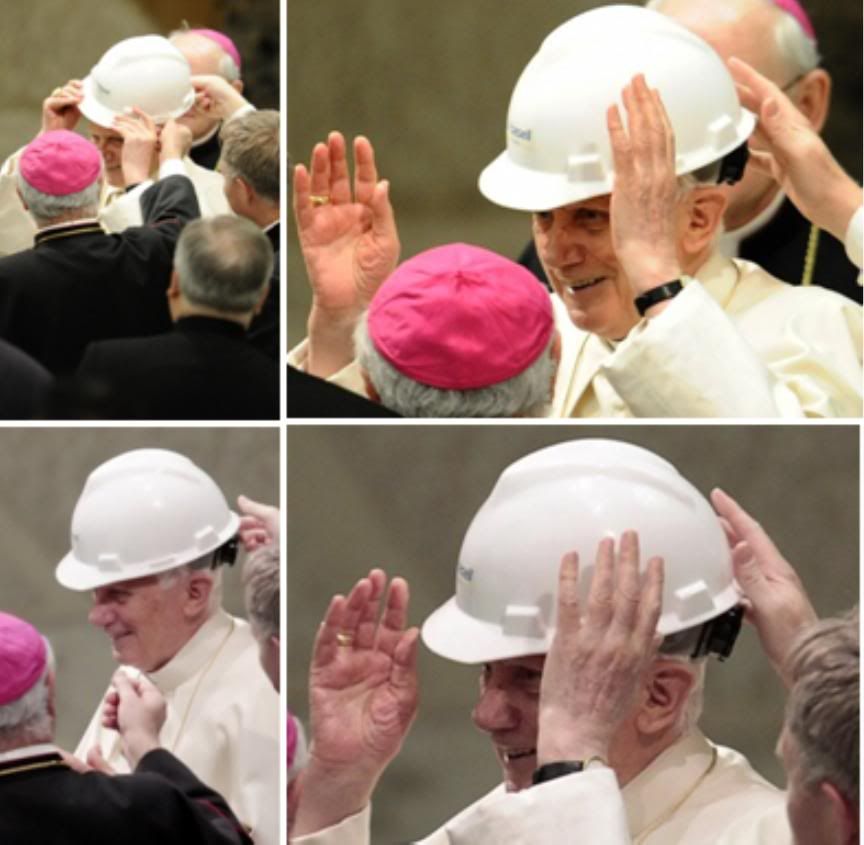
...because afterwards, he is wearing one with his name written on the side:
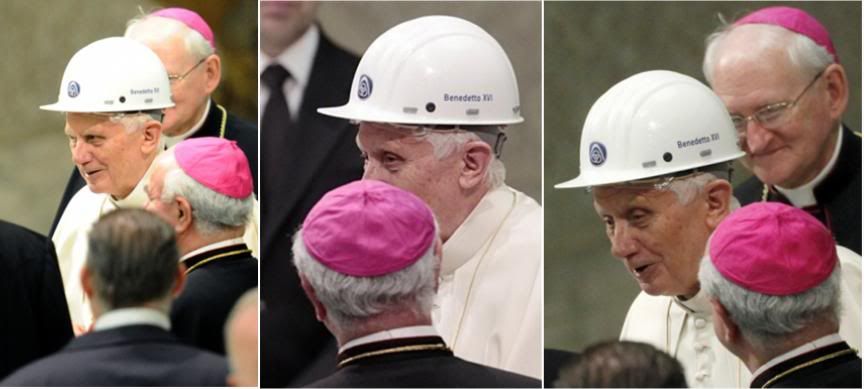
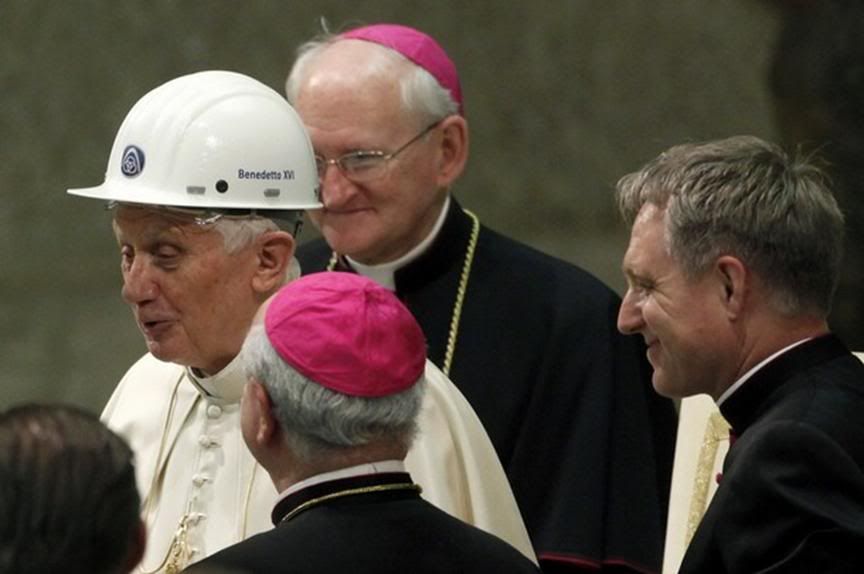

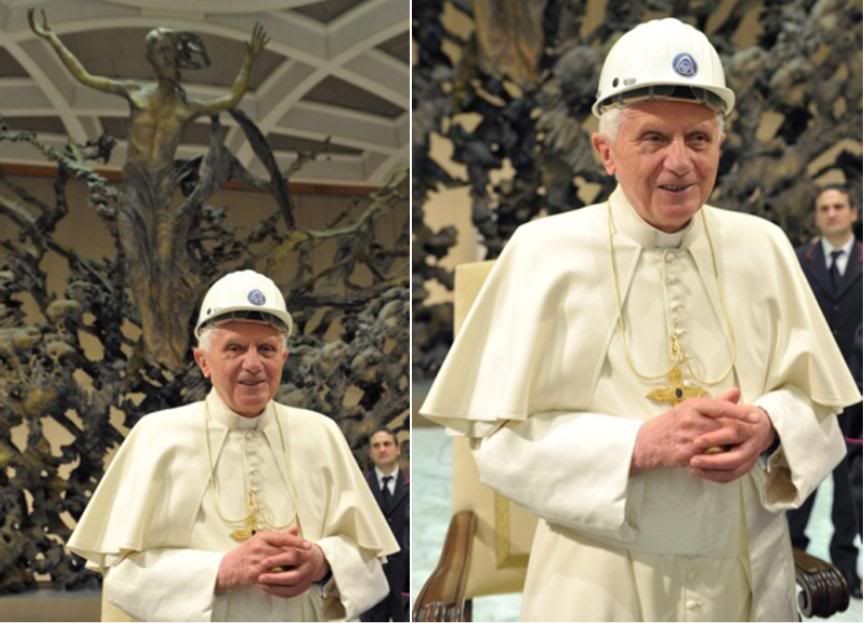
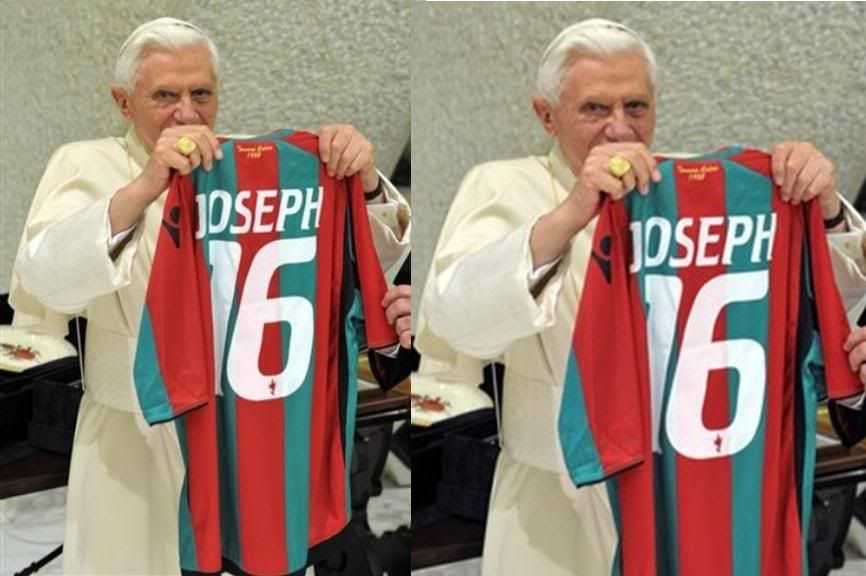
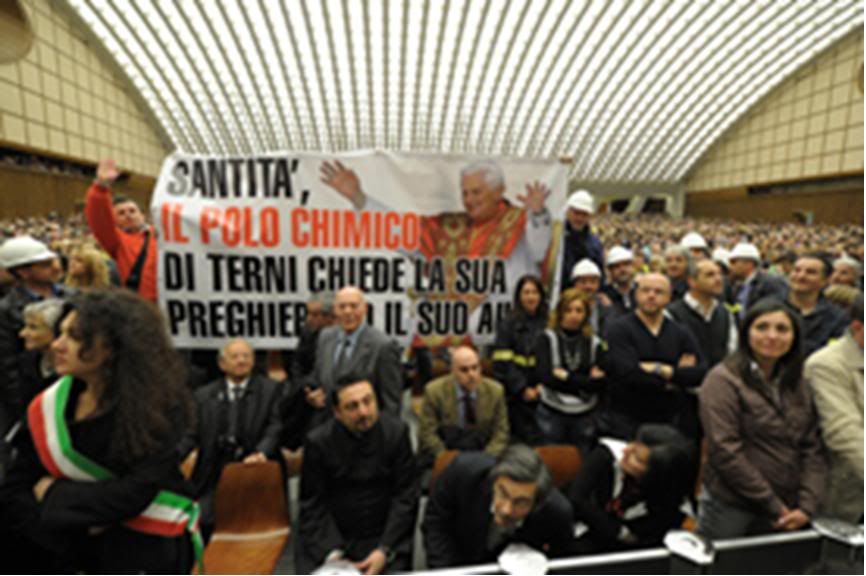
[Modificato da TERESA BENEDETTA 27/03/2011 15:57] |
| |
 26/03/2011 17:35 26/03/2011 17:35 |
|
| | | OFFLINE | | Post: 22.367
Post: 4.992 | Registrato il: 28/08/2005
Registrato il: 20/01/2009 | Administratore | Utente Master | |
|
 Pope to visit Roman memorial
Pope to visit Roman memorial
to victims of 1944 Nazi massacre
Adapted from 2/24/11 post in

Tomorrow, March 27, the Holy Father will visit the national memorial to the 1944 Fosse Ardeatine massacre of Romans by German occupation troops, at the invitation of the Italian association of families with members who died for the homeland.
The occasion is the 67th anniversary of the massacre on March 22, 1944, which was a Nazi reprisal for a partisan attack on some German troops the day before in Rome.
Partisans of the Patriotic Action Group ignited a bomb as a column of German policemen marched through central Rome on Via Rasella. Thirty-three Germans died and Adolf Hitler approved a proposal that 10 Italians should be killed for each German casualty, ordering the reprisal to be carried out within 24 hours.
A total of 335 Italians hastily rounded up were killed - composed of civilians, Italian prisoners of war (up to General rank), previously captured partisans, some inmates from Roman prisons and 75 Jews - in the tunnels of the old Ardeatine quarry in the suburbs of Rome.
Both Paul VI and John Paul II visited the Fosse Ardeatine memorial, which has come to symbolize all the civilian killings perpetrated by the Nazis against Italians in World War II.
Earlier, the Chief Rabbi of Rome said he will be present at the Memorial for the Pope's visit.
One of those killed in the Fosse Ardeatine was Col. Giuseppe Cordero Lanza de Montezemolo, father of Cardinal Andrea Cordero Lanza de Montezemolo, emeritus Arch-Priest of the Basilica of San Paolo fuori le Mura, who was 19 years old at the time. The cardinal will join the Pope in the visit tomorrow.
The following is a long but very unusually interesting interview with Cardinal Montezemolo, to whom the Fosse Ardeatine massacre was a singular tragedy for him and his family.
Remembering the Fosse Ardeatine massacre
Interview with Cardinal Montezemolo
by GIAMPAOLO MATTEI
Translated from the 3/27/11 issue of

On March 27, one of those who will be with Benedict XVI on his visit to the national memorial at Fosse Ardeatine will be Cardinal Andrea Cordero Lanza di Montezemolo (born 1925).
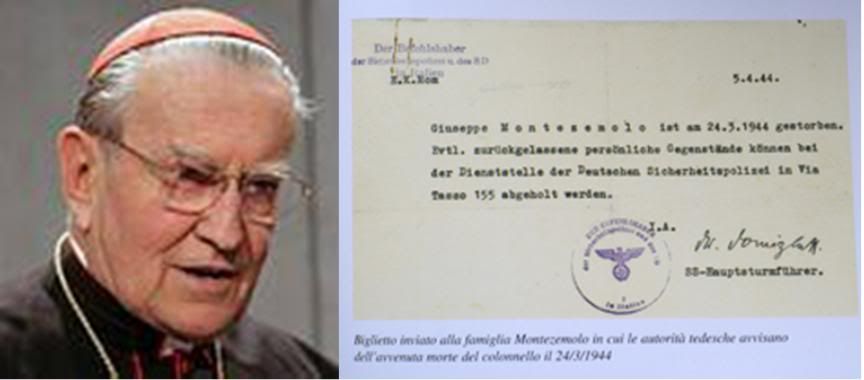 Right photo: Note dated April 5, 1944 from the German police informing the Montezemolos that Giuseppe Montezemolo died on March 24, 1944, and
Right photo: Note dated April 5, 1944 from the German police informing the Montezemolos that Giuseppe Montezemolo died on March 24, 1944, and
that the personal belongings he left could be picked up from the German police station on Via Tasso.
His father, Giuseppe, then a colonel in the Italian armed forces, was among the 335 victims of the massacre carried out by the Germans on March 24, 1944.
At age 19, Andrea was among the first who began digging in the crumbly volcanic tuff of the long-abandoned Ardeatine quarries which the Germans had blown up after the massacre in order to leave no immediately visible evidence of the killings.
Andrea and the others dug out the bodies of the victims and took part in the sad task of identifying them.
In this interview, the cardinal opens up his most intimate memories to relive those days that are so crucial in the history of Italy. He has words of forgiveness for the authors of the massacre and 'a message of hope that such beastly crimes may never again be repeated".
What was your first thought when you learned that the Pope would be visiting the Fosse Ardeatine where your father was killed and subsequently buried?
Surprise, commotion, gratitude. Surprise because, I must confess, I had not expected it. Commotion because the Fosse Ardeatine is an important page in my personal story as well as of all Italy.
Surprise and commotion turned into being thankful to the Pope for having decided to make the visit. It is a great gesture. Basically, it will also be a first time for me. I was serving abroad in the Vatican foreign service at the time that Paul VI in 1965 and John Paul II in 1982 made their visits.
You were only 19 when your father was killed. What are your lasting memories of that time?
I often live those days, moment by moment. As if it was now. My family, after September 8, 1943, had been forced to go underground. it was a complicated life, when we lived with bated breath. In all that fear, trepidation and pain, we never lost hope of living in a better time, when there would be no war.
You had to go underground because of the leading role your father played?
The Germans knew my father well. He had been in the supreme command of the Italian armed forces, and then at the front. The events that followed July 25, 1943, [when Benito Mussolini was forced from office after 21 years as Italy's dictator], changed everything. General Badoglio, the new head of government, asked my father to be the head of his personal secretariat. Then on September 8, another upsetting event. General Giorgio di Bergolo had constituted the command for the Rome as an open city, and named my father to administer it. He was part of the delegation that negotiated a ceasefire with the Germans. But a few days later, the Germans began imprisoning all the Italian authorities. Calvi had asked my father to accompany him to Germany, but he preferred to remain in Rome. He went underground in order to continue trying to contribute towards the liberation of Italy.
So you all went underground in September 1943...
Yes, my father had established the clandestine military front. He was the representative of the southern command of occupied Italy. Not at all easy, since all the work had to be in secret. Our family was warned to be vigilant at every step. But soon we had to leave our home in via Vico and we got dispersed to various places in Rome. My mother and three sisters were given refuge at the college of Trinita dei Monti. My older brother and I frequently changed our hiding place in order not to be captured. For some time, I lived at the Pontifical Ukrainian College on the Janiculum.
On January 25, 1944, your father was arrested and jailed in the notorious prison on Via Tasso.
He was arrested in circumstances which have never been cleared. He had false papers, but his face was too well known. At the time, he was posing as an engineer or as a professor. We tried to keep track of him when he was in jail, but he sent us word many times not to risk being caught because they would use us as hostages. We managed to exchange notes through the clean laundry that an old lady took to him in jail - my mother sewed notes into the shirt collars.
Then the partisan attack against the German patrol on Via Rasella on March 23, 1944, sent up everything in smoke. including attempts to free him...
The Germans carried out their reprisal within 24 hours after three members of their patrol were killed in the attack. In just a few hours, they managed to assemble prisoners from the jails in Via Tasso and in Regina Coeli along with many Jews. The rest is history.
Your father, as a clandestine military commander, had requested expressly all anti-German forces to avoid attacks like those on Via Rasella, especially in the large cities, because he said that the reprisal would certainly involve civilians...
His specific order said "In the major cities, the gravity of consequent reprisals prevents us from conducting guerrilla activities". Among his priorities was to protect civilians. He was sure that attacks against German forces in Rome would merely lead to useless deaths from German reprisals.
You only confirmed the death of your father at Fosse Ardeatine when you recovered his corpse in July 1944...
Yes, but all the circumstances make us believe that he was among those killed in Fosse Ardeatine. On March 24, the clean laundry sent to him was refused with the dry statement, "Col. Montezemolo is dead".
The particulars of the massacre only came out much later. There were many confused rumors. The exact extent of the tragedy was not immediately perceived because the Germans were still in control. So in those days, communications were catch as catch can.
You were among the first to dig among the ruins of teh explosion caused by the Germans in order to hide all the corpses of their victims...
I experienced it all first hand, during the summer of 1944 - the recovery and identification of the victims. It was very intensive labor that saw exceptional participation. It is true that the Germans had set off two bombs to close up the entrance to the quarry and thus hide the place of the massacre.
But by patient digging, we found exactly where the victims were killed. It was not easy to extract the bodies, both physically as well as emotionally. To see all those murdered bodies brought a sense of horror and sorrow beyond imagination that even after all these years, has remained in me.
How were the bodies identified?.
The work was very careful, delicate and competent - and it was carried out by a medico-legal expert, a Jew. He was able to identify practically all the 335 victims, even if they were already in advanced decomposition. I went everyday to follow the work and contribute what I could.
Each family who thought they may have had a relative among the victims was asked to fill out a form giving us all the information that might be useful for identifying them. I identified my father from the shirt that my mother told me would have his initials sewn on the breast pocket - and by his wedding ring.
 Extreme right: Photo of the last note Col. Montezemolo was able to send his wife - kept at the War Memorial ARchives.
How do you remember your father?
Extreme right: Photo of the last note Col. Montezemolo was able to send his wife - kept at the War Memorial ARchives.
How do you remember your father?
His character, I feel, is outlined in the last note that he managed to send us from his cell in Via Tasso. He wrote tender words to my mother: "I did not know how much I love you, and all I regret is not being with you and our children... I trust in God. But we must help ourselves. I can only resist and endure. And I will do so as far as it is humanly possible."
He was only 43 when he was killed....
Yes, he was born in 1901. He served as a volunteer with the Alpine forces in World War I, then he became a civil engineer, before undertaking a military career successfully.
I remember most his idealism and gentility. He was a man who strove for equilibrium, values, wisdom, which he lived with a certain rigidity despite his affability. It was a burden for him that he had to live away from his family in those difficult years of political tension and war which took him away. And when he was home, we saw him mostly during meals. But he was always very concerned about how we were doing in school.
And to continue with your father's service, you decided to volunteer in the war for liberation...
I believed it was only right to give what I could for the good of the homeland. So, for a few months, I was with a military group that happened to have named itself in honor of my father.
Meanwhile, I enrolled in the faculty of architecture, and after the war, I graduated and practised the profession for ten years. Then I was surprised by that mysterious reality which is a vocation for the priesthood.
Insofar as my experience as a volunteer in the war for liberation, before deciding to be an architect, I had wanted to pursue a military career which was almost obligatory in my family. In 1942, my brother entered the military academy and became an official. It was supposed to be my turn the following year. On that morning of September 8, 1943, when we had to go into hiding, I was supposed to leave for Modena to undergo the physical examination for admission to the academy. But I remember that my father had been telling me for several days not to leave Rome under any circumstances. I could not understand why he was so adamant on this. I was angry, saying it would make me lose one year. But he would not be moved. Later, it came to me that at age 19, I was still incapable of fully evaluating reality.
You also worked with Pierluigi Nervi [famous Italian contemporary architect and structural engineer, who designed, among other things, the Aula Paolo VI, many landmark sports palaces in Rome, and the UNESCO headquarters in Paris.] What do you think of the monument at the Fosse Ardeatine mausoleum?
I think it is a work that was well executed and which has the right equilibrium, giving a sense of spirituality. Shortly after the war ended, the Commune of Rome launched a competition for a design to set up the Fosse Ardeatine memorial and construct an appropriate monument, It was the first architectural competition in postwar Italy. Unfortunately, I was too young to take part and I had not even graduated.
The winner was asked to design the construction of the mausoleum where the victims are now entombed individually, the design of the piazza in front of the quarry, and rebuilding the galleries that the Germans had blown up after the massacre. The memorial was inaugurated on March 25, 1949.
What do you think of the way the tombs are lined up, and all under one huge cement canopy which makes it into a common mausoleum?
It is an excellent arrangement because it gives the impression of brotherhood. The basic idea, very simple but eloquent, was to have just one gravestone, without any celebratory emphasis, but solemn, and silently expressive. This large tombstone is able to highlight the significance of the event and the place.
As for the access galleries, they happen to be of crumbly not compact volcanic tuff like the catacombs nearby. So they are fairly precarious and the work had to to anticipate the risk of collapse.
This is a memorial that brings everyone into agreement: Christians and Jews, believers and non-believers.
The memorial conveys the sense of brotherhood even in death. There has only been reciprocal respect, and never any room for vengeful thoughts or religious conflict. Memorial events have been organized without any problem, in full solidarity and collaboration.
Death really brought diverse people together and made even the living brothers. I remember that during the recovery and identification process, a Catholic priest as well as a rabbi were with us to give the blessings.
About Pius XII - what do you think of the controversy that has surrounded him? What did Romans think of the Pope during the time you had to live in hiding?
No doubt the controversy has set into motion enormous speculation. Just as there is no doubt at all that Pius XII worked, above and beyond any mistrust, in behalf of all who were persecuted. It is right that the historians have their say. But I think that the most serious and extensive studies undertaken so far confirm what the direct witnesses have always said and known.
What do you feel about the authors of the Fosse Ardeatine massacre? Is forgiveness possible?
In the Christian view, there is only forgiveness. Which does not mean that it leads to forgetting or to justifying any wrong done, for that matter. Of course, justice should take its course. But it is humanly useless to continue to persecute those who have committed such serious crimes. For the Christian, forgiveness is an act of love that does not expect anything in return.
Did you ever meet Erich Probke, who was the principal executor of the massacre, along with Herbert Kappler? Now, at 98, he lives in Rome under permanent house arrest.
Personally no. The incident has made us take widely divergent roads. But one of my sisters exchanged letters with Priebke to make him know that the death of our father will always be a wound for us.
Actually, it's an amputation. A wound heals; an amputation remains. But as a family, we have always considered it useless to rage against my father's killers. We chose forgiveness, not revenge.
Do you see a link between Benedict XVI's visit tomorrow and his visit to Auschwitz in 2006?
At Fosse Ardeatine, the Pope will be making a private visit, without any special message other than the fundamental values of Christian love which transcends nationality and religion. It will be an act of homage to a historical event, to persons who must never be forgotten. More generally, an embrace in prayer for all the victims of all wars.
His presence will be a new consolation to the families of the victims and will confirm for them that their sacrifice was not useless.
How were the ceremonies last March 24 on the actual anniversary?
I saw President Napolitano. He was genuinely moved. It was a good idea to have schoolchildren from various parts of Italy take part. The rites were simple. The names of all the victims were read. Christian and Jewish prayers were said .
There is a significant coincidence of dates which concerns you personally. In 2006, on March 24, 62 years after the massacre, you were made a cardinal by Benedict XVI. What did you feel that day in St. Peter's?
For me, a truly impressive coincidence. Since 1945, I join my family and we go to the Fosse Ardeatine to pray. Now, there are so many of us - my brother, three sisters, 16 nieces and nephews, 20 grandchildren and two great-grandchildren.
In 2006, we had made our usual plans for March 24 when I was informed of my nomination. That day at St. Peter's, when I was dressed in cardinal red - the color of blood to symbolize martyrdom - I carried within me the sacrifice of my father. It is one more reason for me to be grateful to Benedict XVI.
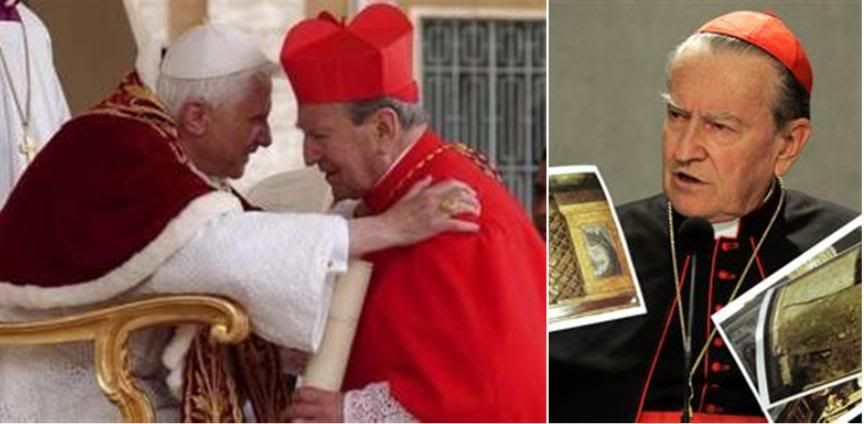 Right photo, Cardinal Montezemolo at a 2009 news conference to describe the findings of a probe into the sarcophagus of St. Paul. He could not have thought in 1944 that 64 years after he helped excavate the remains of the Fosse Ardeatine victims, he would be a protagonist in an even more historic excavation - the verification of the tomb of the Apostle Paul under the main altar of San Paolo fuori le Mure.
Right photo, Cardinal Montezemolo at a 2009 news conference to describe the findings of a probe into the sarcophagus of St. Paul. He could not have thought in 1944 that 64 years after he helped excavate the remains of the Fosse Ardeatine victims, he would be a protagonist in an even more historic excavation - the verification of the tomb of the Apostle Paul under the main altar of San Paolo fuori le Mure.[Modificato da TERESA BENEDETTA 27/03/2011 17:42] |
| |
 26/03/2011 21:18 26/03/2011 21:18 |
|
| | | OFFLINE | | Post: 22.368
Post: 4.993 | Registrato il: 28/08/2005
Registrato il: 20/01/2009 | Administratore | Utente Master | |
|
 Still in the absence of a English-language report on the Court of the Gentiles launch - available French reports right come from the organizers and are necessarily too lengthy to be translated on the run - here at least is the editorial in tomorrow's issue of OR which accompanies the text of the Holy Father's video message last night. OR itself does not have a summary of the two-day launch in Paris.
From Jerusalem to Paris:
Still in the absence of a English-language report on the Court of the Gentiles launch - available French reports right come from the organizers and are necessarily too lengthy to be translated on the run - here at least is the editorial in tomorrow's issue of OR which accompanies the text of the Holy Father's video message last night. OR itself does not have a summary of the two-day launch in Paris.
From Jerusalem to Paris:
Benedict XVI's Court of the Gentiles
Editorial
by Giovanni Maria Vian
Translated from the 3/27/11 issue of

Benedict XVI's intuition of a new space where laymen and non-believers could be welcomed with friendship to share the quest for God with believers is taking shape.
In the Pope's vision, this initiative was represented by the image of the Court of the Gentiles in the Temple of Jerusalem at the time of Jesus - where, precisely, pagans attracted in some way or curious about Judaism were welcome.
The initiative is being carried out now by the Pontifical Council for Culture with creative originality.
Highly symbolic was the choice of Paris - the City of Light, which has been emblematic of the contradictory and dramatic modernity born our of the ideals and errors of the French REvolution - to launch the initiative.
Doubtless, this has been one of the most important decisions made by a Pope who is as gentle as he is courageous - a man of faith and profound theologian, who has been accustomed since his youth to the confrontation of ideas, especially in the university world, even with those who are outside the visible confines of the Catholic world.
Habitually expressing himself in words understandable to all, Benedict XVI wished to be present in Paris with a video message to young people who had been gathered in front of Notre Dame Cathedral, in the square before it, which is as open as the external court of the Temple in Jerusalem had been open to non-Jews. Even if they remained excluded from the great shrine of a Judaism that was then increasingly characterized by universal aspirations.
Everything changed with the coming of Christ, the light. as seen by the evangelist John, who illumines every human being and who broke down the 'wall of separation' between Jews and Gentiles, and consequently, every division, including believers from non-believers.
In order that the space reserved for the Gentiles next to the Temple would accommodate those for whom it was meant, Jesus chased out those who used the space instead to do profitable business. For this, too, Benedict XVI has made himself understood in many ways, as his last two books have demonstrated in different ways but with extraordinary effectiveness.
Thus his words to the youth assembled at Notre Dame last night resounded to both believers and non-believers, and more generally, to all men and women today.
The Pope renewed the invitation which in the course of centuries and to the end of time, the Church of Christ has never tired and will never tire to extend: Not to be afraid to open up our hearts and society itself to God.
Without fear even of repeating the slogan 'liberty, fraternity, equality' that summarized the ideals of the French Revolution - even if this was subsequently brandished harshly to attack the Church and Christianity, forgetting that these words had been born from Christianity.
Believers and non-believers hold many aspirations in common to build "a world that is new and more free, more just and more fraternal, more peaceful and more happy".
Thus, Benedict XVI urged, in such reciprocal recognition, all mistrust must be dropped by both believers and non-believers: God is not a danger to society and to human life, nor is reason, as long as it does not yield to special interests and to 'utility' as often happens.
Thus, too, Benedict XVI invited the gathered youth, without distinguishing between believers and non-believers, not to linger in the courtyard but to enter the Cathedral where, like incense, the prayers and songs of a Vespers service were raised to God.
[Modificato da TERESA BENEDETTA 27/03/2011 04:19] |
| |
 27/03/2011 17:04 27/03/2011 17:04 |
|
| | | OFFLINE | | Post: 22.369
Post: 4.994 | Registrato il: 28/08/2005
Registrato il: 20/01/2009 | Administratore | Utente Master | |
|
 March 27, Third Sunday in Lent
March 27, Third Sunday in Lent
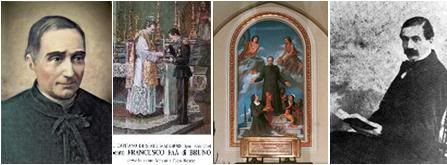 BLESSED FRANCESCO FAA DI BRUNO (Italy, 1825-1888), Soldier, Mathematician, Priest
BLESSED FRANCESCO FAA DI BRUNO (Italy, 1825-1888), Soldier, Mathematician, Priest
He was one of the many sainted figures like Don Bosco who emerged in late 19th century
Turin. Son of a marquis, he was well educated and a trained officer in the Sardinian Army
around the time of Italian reunification. He caught the attention of King Vittorio Emanuele
who wanted him to tutor his two young sons. However, the King withdrew the offer because
of strong anti-Catholic feeling at that time. Francesco went to Paris to study astronomy and
mathematics, which was to be his lifelong passion. He studied with the two French scientists
who discovered the planet Neptune. Returning to Italy, he taught math at the University of
Turin but did significant charitable work on the side. Notably, he founded the Society of
St. Zita, originally to assist domestic servants and later, unwed ,others as well. He set up
a hostel for the aged and raised funds for a church to honor soldiers who died in the wars
of reunification. He obtained an age dispensation from Pius IX to study for the priesthood
and was ordained at age 51. He continued to teach but he also shared his inheritance with
the poor and set up a hostel for prostitutes. He published numerous articles on mathematical
theory for leading scientific journals and developed the Faa di Bruno mathematical formula
for the derivative of composite functions in calculus. He was beatified in 1988.
Readings for today's Mass: www.usccb.org/nab/readings/032711.shtml
OR today.

In video-message to Paris, Benedict XVI addresses youth
to close the two-day events inaugurating the Court of the Gentiles:
'Room for dialog and brotherhood between believers and non-believers'
A front-page editorial accompanies the main story (translated in the post above). Other papal news: The Holy Father addresses 8,000 pilgrims from Terni, a steel and chemical manufacturing center now gravely stricken by the economic crisis. Page 1 international news: Rebels regain some lost ground in Libya helped by the allied no-fly zone; street protests spread to Syria where government forces fire on protesters; and still no prospects for resolving the nuclear reactor problems in Fukushima. In the inside pages, OR's interview with Cardinal Montezemolo as a 19-year-old whose father was one of the 355 murdered by the Nazis in a reprisal massacre at Rome's Fosse Ardeatine in 1944 (also translated and posted above), on the eve of the Pope's visit to the memorial today.
THE POPE'S DAY
Visit to the Fosse Ardeatine mausoleum and memorial. Address in Italian.
Sunday Angelus - The Holy Father reflects on today's Gospel of the Samaritan woman.e encounter with Jesus at the well.
After the prayers, he reiterates his concern over the situation in Libya and the rest of the Middle East, appealing
yet again for dialog in place of arms and violence.
[Modificato da TERESA BENEDETTA 28/03/2011 04:50] |
| |
 27/03/2011 18:48 27/03/2011 18:48 |
|
| | | OFFLINE | | Post: 22.370
Post: 4.995 | Registrato il: 28/08/2005
Registrato il: 20/01/2009 | Administratore | Utente Master | |
|
 THE POPE AT FOSSE ARDEATINE
THE POPE AT FOSSE ARDEATINE




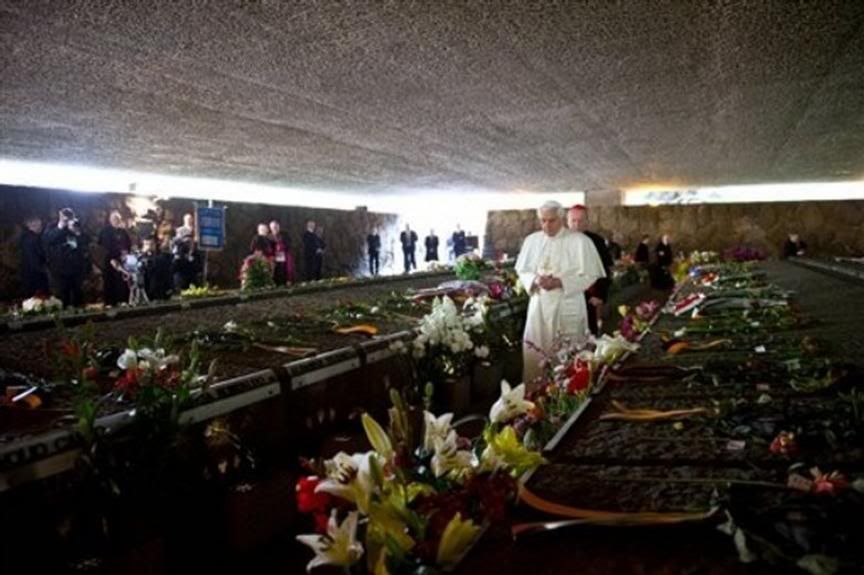 At Fosse Ardeatine:
At Fosse Ardeatine:
Pope recalls horror
of wars, past and present

March 27, 2011
Pope Benedict XVI, visiting the site of a World War II massacre, remembered the “abhorrent effects” of war, of violence on man by man, and at the Angelus later, he reiterated his continuing appeal for an end to the use of weapons and space for dialogue in the conflicts that are currently raging in Libya and the North African region.
Poignantly underscoring this renewed Papal appeal, were the images of Pope Benedict Sunday morning, as he walked among the tombs of 335 Italians massacred in the Fosse Ardeatine, (Ardeatine caes, formerly quarries), during the Nazi Occupation on March 24, 1944, in retaliation for a partisan attack on Nazi troops in central Rome a day earlier.
Adolf Hitler himself ordered the execution within 24 hours of ten Italians for every one German killed in that attack. 335 Italians, most of them priners in two of the Nazi prisons in centrla Rome, were rounded up and transported to the old quarry site on Via Ardeatine, brought into the caves and, one by one, shot dead at point blank range.
The victims included Italian army officers, resistance fighters, innocent civilians and 75 members of the city’s Jewish community. The youngest victim was 15 years old.
On Sunday, accompanied by Rome’s Chief Rabbi Riccardo Segni, and Cardinal Andrea Cordero Lanza di Montezemolo, emeritus Archpriest of St Paul’s outside the Walls, the Pope laid a basket of red roses at the feet of the plaque commemorating the victims.
He then entered the cavern containing the tombs, pausing before three; the first, that of Cardinal Montezemolo’s father, who was a colonel in the Italian army and a resistance leader. The second, that of Don Pietro Pappagallo a priest of the Roman diocese proclaimed a XX century martyr by John Paul II, for his self sacrifice in helping those persecuted under the Fascist and Nazi regimes; and finally that of Alberto Funaro, a Jew, whose nephew, a Rabbi of the same name, stood alongside the Pope as he prayed.
Emerging from the darkened crypt, Pope Benedict addressed a gathering of families and relatives of the Ardeatine victims, and said:
“What happened here March 24, 1944 is a most grave offense against God, because it is the deliberate violence of man by man. It is the most abhorrent effect of war, any war, while God is life, peace, communion...
Like my predecessors, I have come here to pray and renew the memory. I have come to invoke Divine mercy, which alone can fill the void, the abyss opened by men who, when driven by blind violence, deny their dignity as children of God and brotherhood with each other...
Yes, wherever he is, on every continent, in every nation, man is the son of that Father in heaven, he is brother to all humanity. But this being the son and brother is not a given.
Unfortunately, this is revealed by the Ardeatine Caves themselves. We must want it, we must say yes to good and no to evil. We must believe in the God of love and life, and reject any false image of God, that betrays His holy name and thus betrays man, made in His image.
Therefore, in this place, a painful reminder of the most horrendous evil, the real answer is to join hands as brothers, and say: Our Father, we believe in You, and with the strength of Your love we desire to walk together in Peace, in Rome, Italy, in Europe, throughout the world.
Before taking his leave, in the book of witness at the entrance to the cave, Pope Benedict wrote:' Non timebo quia Tu mecum es' - I shall fear no evil, because You are with me.

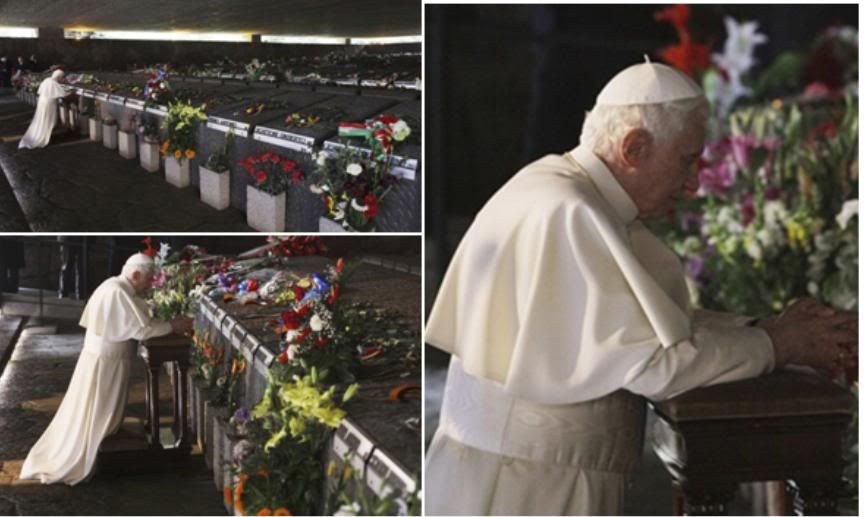
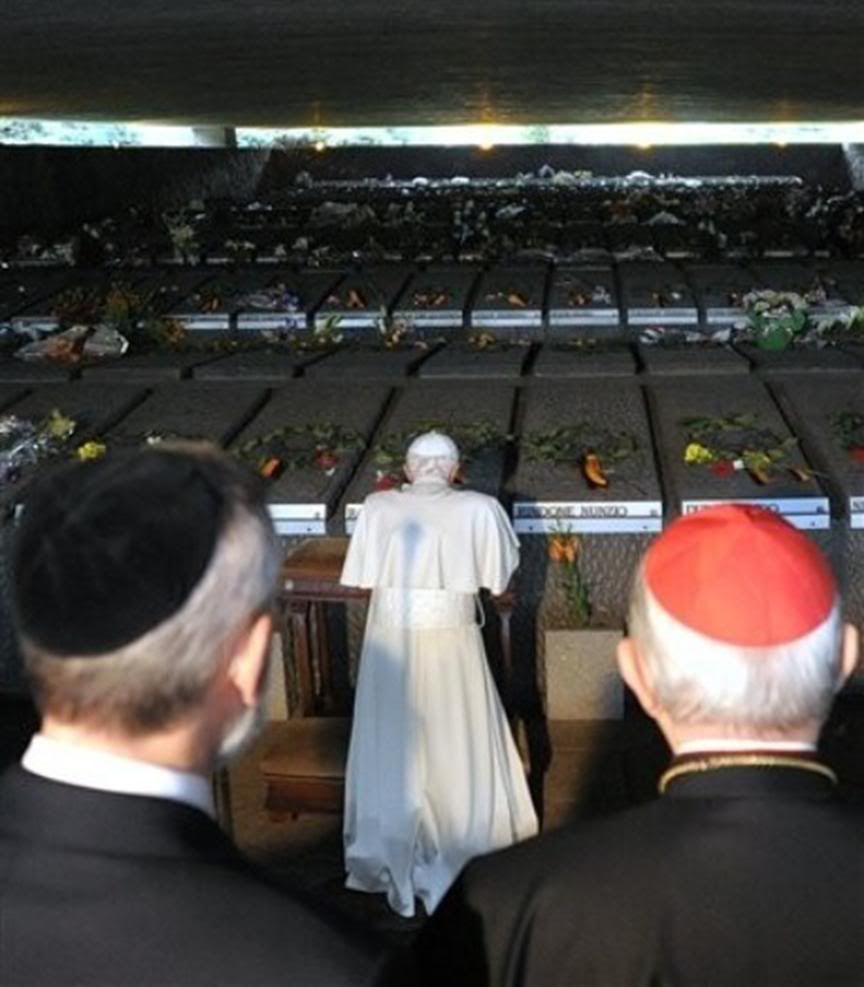
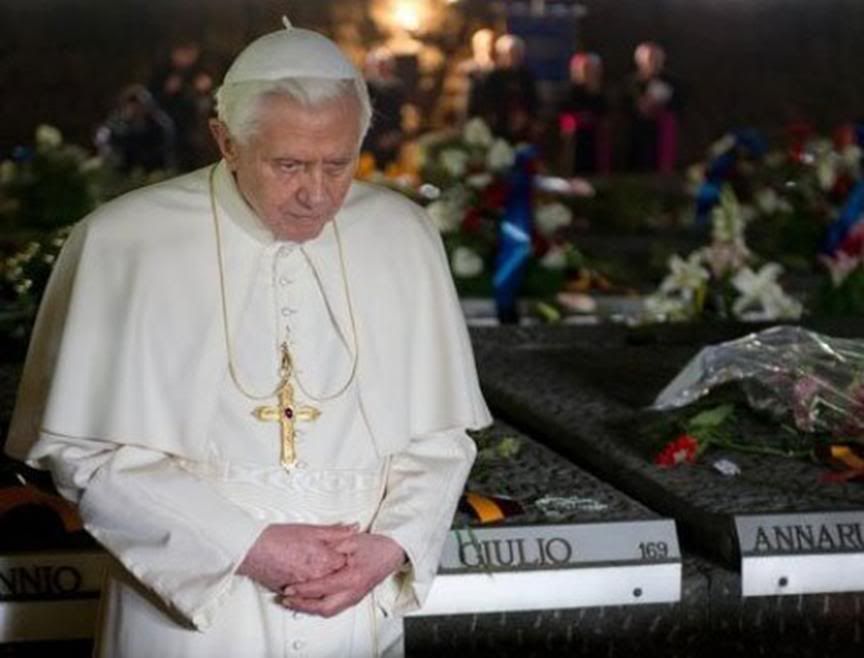
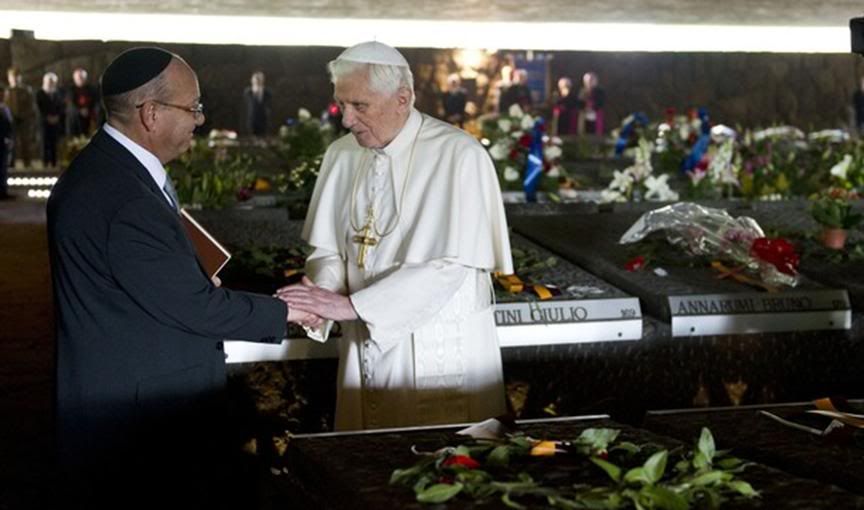
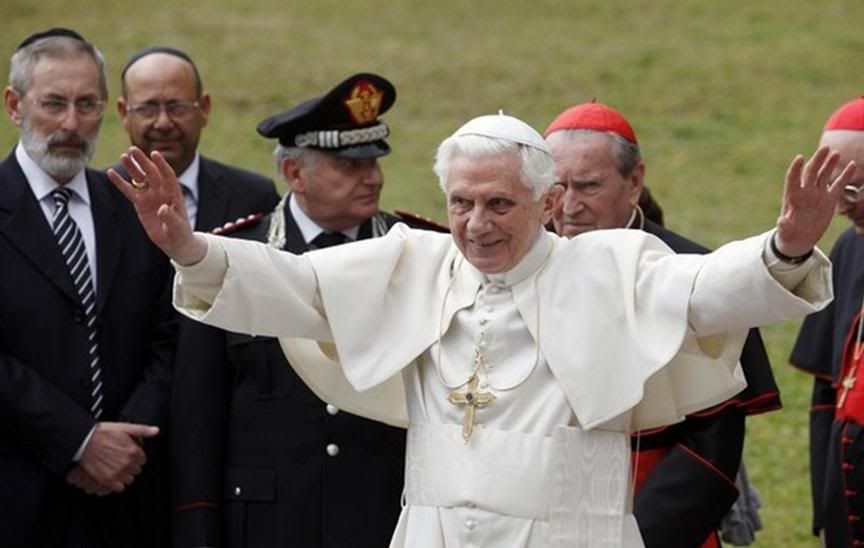
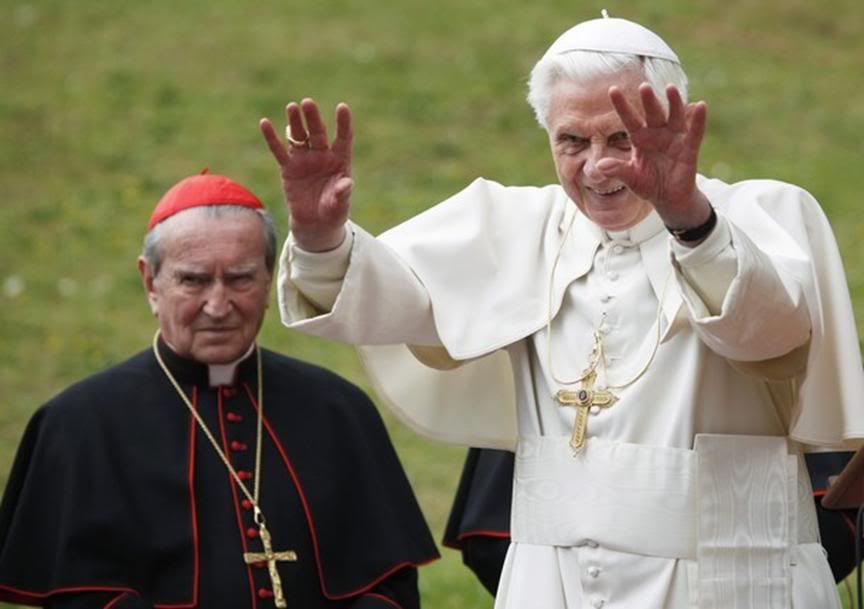


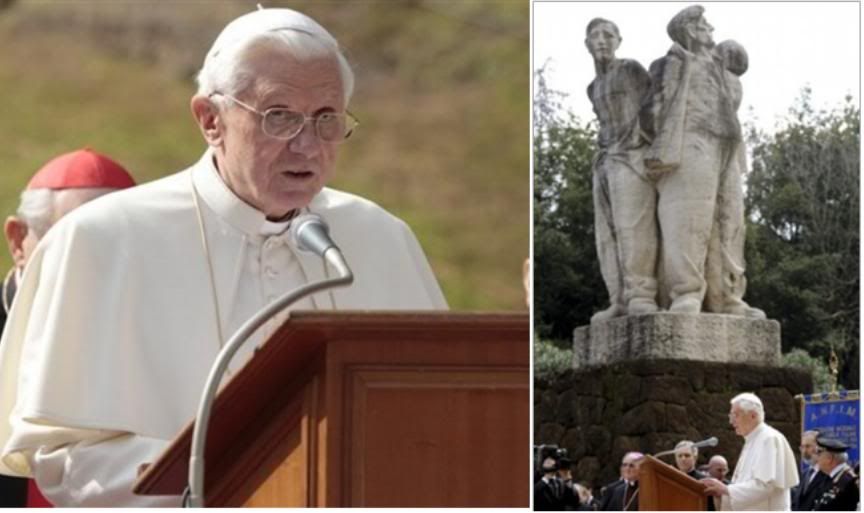
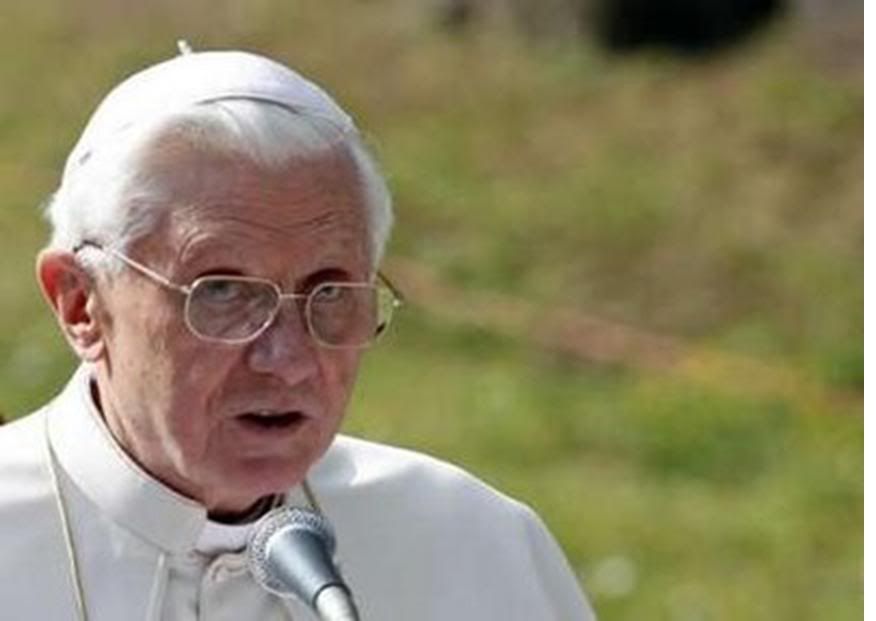 Here is the full text of the Pope's address, in a translation provided by Vatican Radio:
Here is the full text of the Pope's address, in a translation provided by Vatican Radio:
Dear brothers and sisters!
I very gladly accepted the invitation of the “National Association of Italian families of the martyrs who died for the freedom of the Fatherland" to make a pilgrimage to this shrine, dear to all Italians, particularly the Roman people.
I greet the Cardinal Vicar, the Chief Rabbi, the President of the Association, the Commissioner General, the Director of the Mausoleum and, especially, the families of victims as well as all those present.
"I believe in God and in Italy / I believe in the resurrection / of the martyrs and heroes / I believe in rebirth / and in my homeland / in the freedom of the people."
These words were engraved on the wall of a torture cell, in Via Tasso in Rome during the Nazi occupation. It is the testimony of an unknown person, who was imprisoned in that cell, and demonstrates that the human spirit remains free even in the harshest conditions.
"I believe in God and in Italy": these words struck me because this year marks the 150th anniversary of the unification of Italy, but mainly because it affirms the primacy of faith, from which to draw confidence and hope for Italy and its future.
What happened here March 24, 1944 is a most grave offense against God, because it is the deliberate violence of man against man. It is the most odious effect of war, any war, while God is life, peace, communion.
Like my predecessors, I have come here to pray and renew the memory. I have come to invoke Divine mercy, which alone can fill the void, the abyss opened by men who, when driven by blind violence, deny their dignity as children of God and brotherhood with each other.
I, too, as Bishop of Rome, a city consecrated by the blood of the martyrs of the Gospel of Love, I come to pay homage to these brothers, who were killed not far from the ancient catacombs.
"I believe in God and in Italy." In this testimony etched in a place of violence and death, the link between faith and love of country appears in all its purity, without any rhetoric.
Whoever wrote those words did so only for personal conviction, as his last testimony to the truth he believed, which renders the human spirit regal even at its extreme abasement. Every man is called to achieve their own dignity in this way, testifying to that truth which he recognizes with his own conscience.
Another testimony struck me, and this was found here in the Ardeatine Caves. A sheet of paper on which a victim had written: "God my great Father, we pray so that you can protect Jews from the barbaric persecution. 1 Pater Noster, Ave Maria 10, 1 Gloria Patri."
At that moment so tragic, so inhuman, in the heart of that person was the highest prayer, "God my great Father." Father of all! Just as on the lips of Jesus, dying on the cross: "Father, into thy hands I commend my spirit."
In that name, "Father", is the sure guarantee of hope, the possibility of a different future, free from hatred and revenge, a future of freedom and fraternity, for Rome, Italy, Europe and the world.
Yes, wherever he is, on every continent, in every nation, man is the son of that Father in heaven, he is brother to all humanity. But son and brother is not a given. Unfortunately, this is revealed by the Ardeatine Caves themselves. We must want it, we must say yes to good and no to evil.
We must believe in the God of love and life, and reject any false image of God, that betrays His holy name and thus betrays man, made in His image.
Therefore, in this place, a painful memorial of the most horrendous evil, the real answer is to join hands as brothers, and say: Our Father, we believe in You, and with the strength of Your love we desire to walk together in Peace, in Rome, Italy, in Europe, throughout the world. Amen.
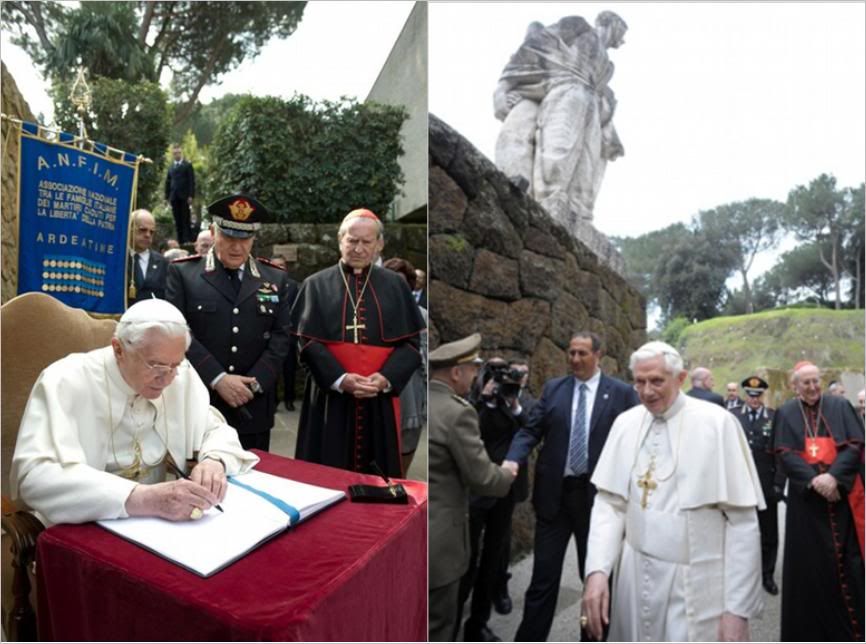 Pope visits Roman site
Pope visits Roman site
of 1944 Nazi atrocity
By FRANCES D'EMILIO

ROME, March 27 (AP) — Pope Benedict XVI on Sunday prayed at the memorial to victims of a 1944 massacre that was one of the worst atrocities by German occupiers in Italy during World War II and denounced what he called the "abominable" legacy of violence unleashed during war.
The visit won Jewish praise that Benedict had taken yet another step to heal centuries of painful Vatican-Jewish relations.
The German-born Pontiff visited the Ardeatine Caves on the outskirts of Rome to mark the anniversary of the killings of 335 civilians in Rome to avenge an attack by resistance fighters that killed 33 members of a Nazi military police unit.
Among those in attendance were children and other relatives of the victims, with some of the elderly family members weeping at the memory of their loss and clutching flowers.
"What happened here on March 24, 1944, is a very grave offense to God, because it is violence perpetrated by man upon man," the pope said in speech at the simple memorial fashioned out of the walls of the caves. "It is the most abominable effect of the war, of every war," the Pontiff said.
The wounds are still fresh for Rome's tiny Jewish community. Many of them expressed outrage last fall when former SS Capt. Erich Priebke, 97, was allowed to go shopping and to church in Rome. Priebke was sentenced to life imprisonment for his role in the massacre but later given house arrest due to his age.
Elan Steinberg, a leader of the American Gathering of Holocaust Survivors and their Descendants, praised the Pontiff for paying "moving homage to the victims of this Nazi crime — Catholic and Jew."
"Coming on the heels of his strong pronouncement exonerating Jews in the death of Jesus, this latest gesture by the German-born Benedict is a further dramatic step in binding the wounds that have disturbed Vatican-Jewish relations in recent years," Steinberg said in a statement.
The landmark exoneration came in the Pope's new book, Jesus of Nazareth-Part II, in which Benedict lays out biblical and theological reasons why there is no basis in Scripture for the argument that Jewish people as a whole were responsible for Jesus' crucifixion. Interpretations to the contrary have been used for centuries to justify the persecution of Jews.
Steinberg also voiced the "shock and disbelief" of Holocaust survivors that Priebke "is allowed shopping trips and other excursions," and appealed to Italian legal authorities to "put an end to this perversion of justice.'"
In 1994, Priebke was extradited to Italy from Argentina, where he had lived for years, and put on trial. The Germans had ordered 10 Italians to be executed for each of the 33 Nazis killed by resistance forces in Rome a day earlier. Priebke admitted shooting two people and rounding up victims, but insisted he was only following orders.
[Modificato da TERESA BENEDETTA 28/03/2011 05:41] |
| |
 27/03/2011 19:56 27/03/2011 19:56 |
|
| | | OFFLINE | | Post: 22.371
Post: 4.996 | Registrato il: 28/08/2005
Registrato il: 20/01/2009 | Administratore | Utente Master | |
|

 ANGELUS TODAY
ANGELUS TODAY
The Holy Father today reflected on the Gospel narration about Jesus and the Samaritan woman at the well. After the Angelus prayers, he made a strong appeal for an end to the use of weapons in Libya.
Here is how he synthesized his Gospel reflection for the English-speaking faithful:
I offer a warm greeting to all the English-speaking visitors present for this Angelus prayer. In today’s Gospel, Jesus speaks to the Samaritan women of the gift of the Holy Spirit, the water which wells up to confer eternal life in those who believe.
Through our Lenten observance may all of us be renewed in the grace of our Baptism and prepare with hearts renewed to celebrate the gift of new life at Easter. Upon you and your families I invoke God’s blessings of joy and peace!
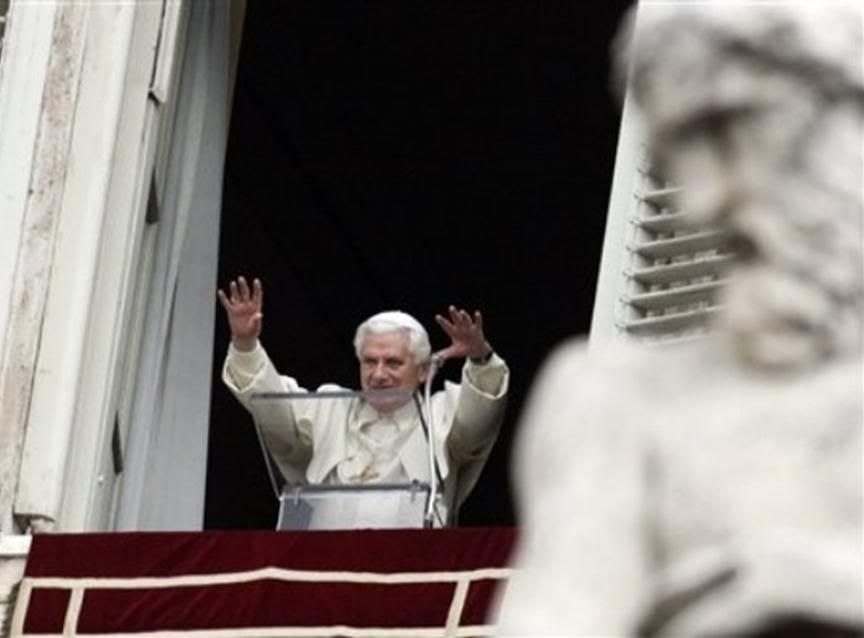
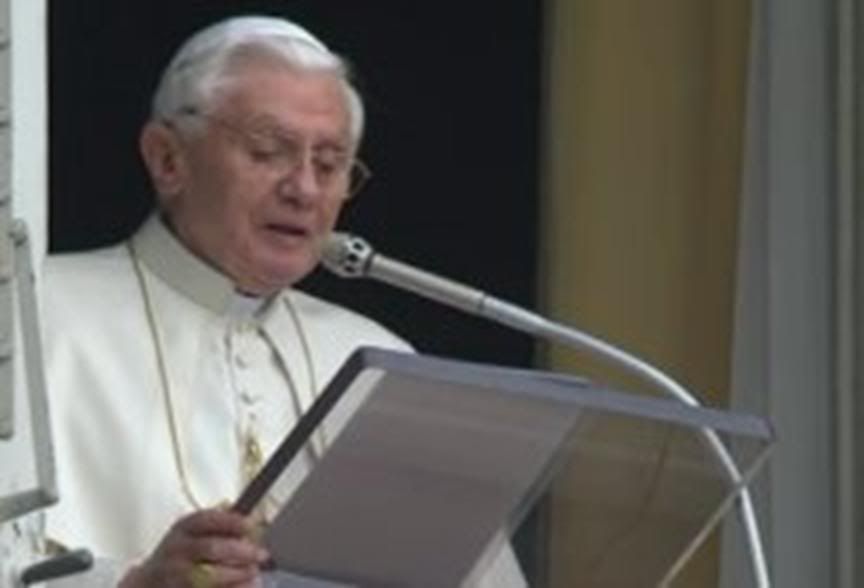 Here is a translation of the Pope's words at Angelus today:
Here is a translation of the Pope's words at Angelus today:
Dear brothers and sisters:
This third Sunday in Lent is characterized by the famous dialog of Jesus with the Samaritan woman, narrated by the evangelist John.
The woman came every day to draw water from an ancient well from the time of the patriarch Jacob, and that day, she found Jesus, seated, "tired from his journey" (Jn 4,6).
St. Augustine comments, "Of course, Jesus was tired...You created the strength of Christ, you have re-created the weaknesses of Christ"... With your power you created us, with your weaknesss, you have come to search for us" (Ioh. Ev., 15, 2).
Jesus's weariness, a sign of his true humanity, can be seen as a prelude to his passion, with which he would bring to fulfillment the work of our redemption.
In particular, in his meeting with the Samaritan woman at the well, the theme of Christ's 'thirst' emerges, that which culminated in his cry from the Cross: "I thirst" (Jn 19, 28).
Certainly, this thirst, like his weariness, has a physical basis. But Jesus, as Augustine also notes, "was thirsting for the faith of that woman" (In Ioh. Ev. 15, 11), as he thirsts for the faith of us all. The omnipotence of Love always respects man's freedom; it knocks on his heart and patiently awaits a response.
The meeting with the Samaritan woman brings to the foreground the symbol of water, which alludes clearly to the Sacrament of Baptism, source of a new life of faith in the grace of God.
Indeed, this Gospel, as I recalled in the catechesis on Ash Wednesday, is part of the ancient itinerary of preparing the catechumens for Christian initiation, which took place on the great vigil on Easter eve.
"Whoever drinks the water I shall give will never thirst; the water I shall give will become in him a spring of water welling up to eternal life" (Jn 4,14).
This water represents the Holy Spirit, the 'gift' par excellence that Jesus came to bring us from God the Father. He who is reborn in water and the Holy Spirit, namely, in Baptism, enters into a real relationship with God, a filial relation, and can adore him "in spirit and truth" (Jn 4,23-24), as Jesus tells the Samaritan woman.
Thanks to the encounter with Jesus Christ and the gift of the Holy Spirit, man's faith achieves fulfillment in response to the fullness of God's revelation.
Each of us can emulate the Samaritan woman: Jesus awaits us, especially in this season of Lent, to speak to our hearts, to my heart. Let us pause a moment in silence, in our room, or in a church, or in a place apart. Let us listen to his voice which tells us, "If you would only know the gift of God..."
May the Virgin Mary help us not to miss such occasions on which our true happiness may depend.
Pope launches urgent appeal for
an end to use of weapons in Libya

March 27, 2011
Following the midday Angelus prayer this Sunday, Pope Benedict XVI launched the following urgent appeal:
Faced with the increasingly tragic reports from Libya, my trepidation for the safety and security of civilians and my concern for the unfolding situation, currently marked by the use of arms, is growing.
In times of greatest tension, the need to put to use all means available to diplomacy becomes increasingly urgent and to support even the weakest signs of openness and willingness on both sides involved, for reconciliation in search of peaceful and lasting solutions.
In view of this, as I lift my prayer to the Lord for a return to harmony in Libya and the entire North African region, I also appeal to the international bodies and all those in positions of military and political responsibility, for the immediate start of dialogue and the suspension of the use of weapons.
Finally, my thoughts turn to the authorities and citizens of the Middle East, where in recent days there have been several incidents of violence, so that the path of dialogue and reconciliation be privileged in the search for a just and brotherly co-existence.

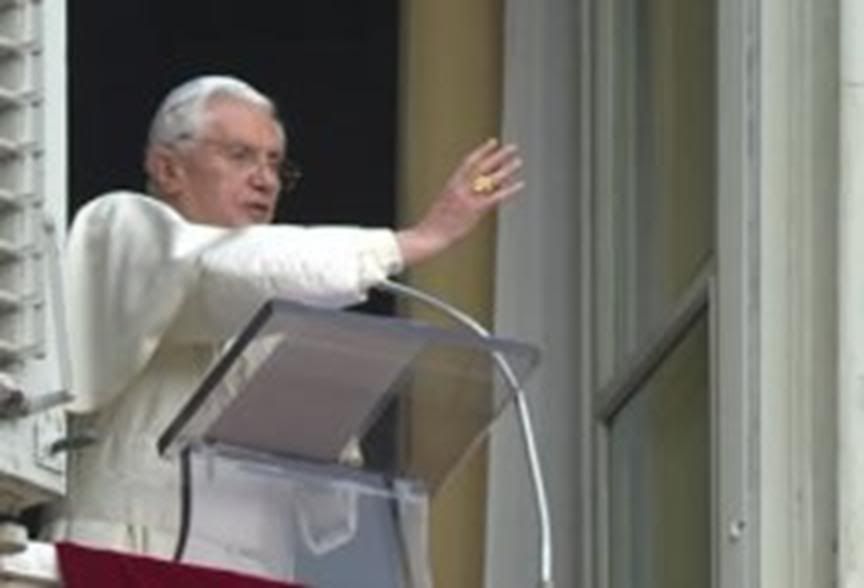
[Modificato da TERESA BENEDETTA 27/03/2011 21:16] |
| |
 28/03/2011 04:25 28/03/2011 04:25 |
|
| | | OFFLINE | | Post: 22.372
Post: 4.997 | Registrato il: 28/08/2005
Registrato il: 20/01/2009 | Administratore | Utente Master | |
|

 In December 2005, to open a thread called IN HIS OWN WORDS in the PRF, on articles and interview with Cardinal Ratzinger before he became Pope, my first post was a translation of excerpts from an interview with Cardinal Ratzinger published by La Repubblica published on May 13, 2005, to mark the 40th anniversary of the end of the Council in 1965. In turn, Repubblica had taken the excerpts from the transcript of an interview done by Pasquale Chessa and Francesco Villari for the Archivio delle Memorie project of RAI, the Italian state broadcasting agency [no information when they did the interview), which was published in the Italian magazine RESET. I have since been unable to find anything about it by Googling RESET or RAI.
In December 2005, to open a thread called IN HIS OWN WORDS in the PRF, on articles and interview with Cardinal Ratzinger before he became Pope, my first post was a translation of excerpts from an interview with Cardinal Ratzinger published by La Repubblica published on May 13, 2005, to mark the 40th anniversary of the end of the Council in 1965. In turn, Repubblica had taken the excerpts from the transcript of an interview done by Pasquale Chessa and Francesco Villari for the Archivio delle Memorie project of RAI, the Italian state broadcasting agency [no information when they did the interview), which was published in the Italian magazine RESET. I have since been unable to find anything about it by Googling RESET or RAI.
Much later, in February 2008, Gemma posted the full excerpts printed by Repubblica on Lella's blog, and I translated the entire thing on Page 3 of IN HIS OWN WORDS freeforumzone.leonardo.it/discussione.aspx?idd=354533&p=3
I thought about this last week when I posted the excerpts by the French magazine LA VIE from a new book called MON CONCILE VATICAN, which assembles various writings by Prof. Joseph Ratzinger in 1962-1967 about the Council (Page 194 of this thread), but did not re-post it. It very much deserves a re-post - after all, this is another forum - as the Italian account is a more intimate account, whereas the excerpts from the French book are more 'substantial' ...
My experience of Vatican II
by Cardinal Joseph Ratzinger
Translated from

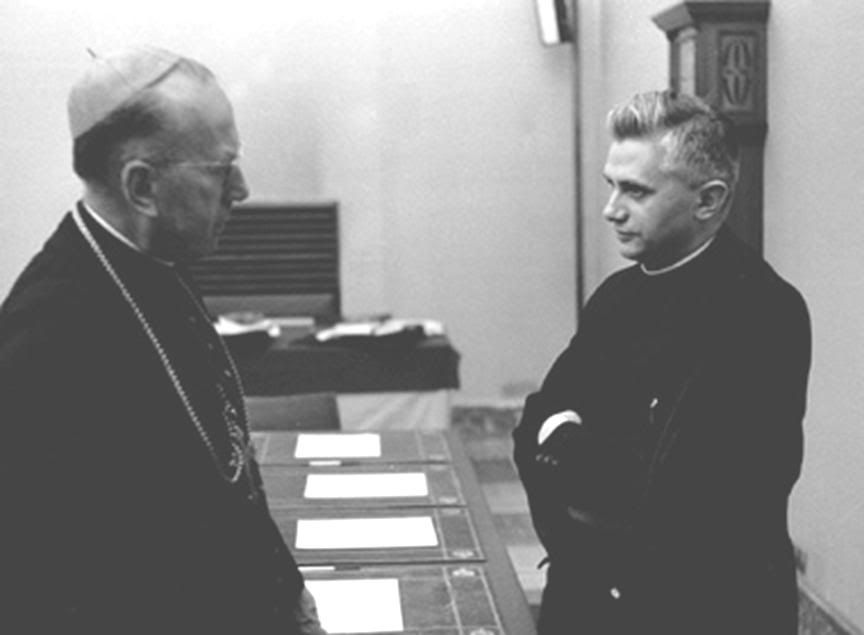
At the time of the Vatican Council, I was a young professor at the University of Bonn. The Archbishop who had jurisdiction over this university was Cardinal Frings of Cologne. I had given a lecture on the theology of the Council which the Cardinal attended; he appreciated it and invited me to join him in the Council.
Before that, he had already asked me to prepare an address for him to deliver in Genoa, at the invitation of Cardinal Siri, about the problems to be dealt with in the Council.
Apparently, Pope John XXIII liked the address very much - it might have been considered not exactly revolutionary but rather audacious – and embracing Frings, he had told him, “ These were precisely my intentions in calling the Council.” [Take note, 'spiritists'. No less than John XXIII gave the imprimatur to Joseph Ratzinger's pre-Council hermeneutic!]
To see the Church alive in the Council, with 3000 bishops present, was truly an exceptional event: rarely in history could one see the Church in that way, to grasp its universality, at a time of a grand new realization of its mission.
Living in Rome
Along with the Cardinal, I lived in the Collegio dell’Anima on Via della Pace – it was an Austrian institution with a very pleasant atmosphere.
Cardinal Frings gathered all the German-speaking bishops at the College and assigned me to give an overview of the Council agenda to the German episcopate.
I was 32 years old and had just started to teach at University, so for me it was a daunting thing, a heavy charge to take on. In effect, the responsibility for charting the course which the German bishops were to follow during the Council fell on my shoulders.
On the one hand, I felt great joy that I was really taking part in the work of the Council, and on the other hand, I felt the weight of my responsibility to God and to history.
The Council was a historic event, even for me personally. I found myself thrown together with so many persons I had only known before through books.
For a young professor who until then had only known the academic world, even simply taking part in Roman life was a completely new reality. To go out for coffee and get to know Roman life – so different from the life I knew at university – left me with many impressions that have marked my life.
The death of John XXIII
And then, Pope John XXIII died. I remember the great sorrow that was felt even in Germany. My country is usually not known to be close to Popes, but this time, the whole country suffered for the dying Pope who was very much loved.
It was incredible to see how this man had been able to unite everyone in extraordinary love for him, drawing everyone closer to the Papacy.
Then of course, there was the matter of the succession. As an academic, I had no role in the Conclave. Cardinal Frings and I did not even talk about it.
But we all thought that the Archbishop of Milan (Giovanni Battista Montini) should be the next Pope – he became prominent when he was deputy Secretary of State at the Vatican, so that even in 1958, when Pope Pius XII died, the consensus had been, “Too bad Montini is not yet a Cardinal, he deserves to be Pope one day.”
So it was no surprise when we learned that this time, Archbishop Montini had in fact been elected Pope. For us, it meant a guarantee of continuity for the Council in the spirit of Pope John, who himself had let it be known that he wished the Archbishop of Milan to succeed him. The new Pope was welcomed as a bearer of hope.
The two Popes
So the Council was a basic experience, even for marking the transition between two Popes, who shared the same fundamental intentions although with completely different personalities.
Roncalli and Montini – alike and yet so different.
It was interesting to have seen Pope John, totally charismatic, who lived in the inspiration of the moment and intimacy with the public, while on the other hand, Pope Paul was an intellectual who reflected on everything with incredible seriousness.
In the case of Montini, I remember, for example, the time when there was a difficult point to make in the Constitution on Revelation - there was resistance to giving the appropriate space to Tradition, which was a very important point.
Pope Paul, with great sensitivity and respect for the bishops and for the theologians, on one hand, but also conscious of his responsibility as guarantor of Tradition, gave us, I think, 18 versions, 18 different ways of how we might treat the point in question, allowing maximum freedom but also safeguarding important doctrinal points.
His sensitivity was, for me, the image of his personality: his consideration for others, respecting collegiality and freedom, but at the same time, maintaining his responsibility for continuity in the life of the Church. He was punctilious in everything he did.
And no, during the Council, I never once met the Archbishop of Cracow [Karol Wojtyla, who, like Ratzinger, had attended all four sessions of Vatican-II, but as a Council Father, since he was already an archbishop. In fact, they met each other for the first time only much later, in the pre-Conclave days after Pope Paul’s death in 1978.]
Encounter with other theologians
As a consultant, I sat in the section assigned to us, and I was therefore able to follow the Council. In the first two months of the Council, I was not an official 'expert' (peritus), just the Cardinal’s private consultant. In November, I was named an official 'expert' by the Pope and from that moment, I participated officially in all the sessions.
Initially, I could participate in all the work behind the scenes, but not regularly at all the sessions. In these circumstances, it was a great thing for me to see all the experts, great personalities whom I had known through studying their books: Henri De Lubac, Jean Danielou (1905-1974), Yves Congar (1904-1995), Marie-Dominique Chenu (1895-1990) and other big names.
It was extraordinary to meet all these venerated figures because they were persons I admired. It was similarly a great thing to see the representatives from other Churches and Christian confessions. And then, of course, the Pope himself (John XXIII).
I had (first) seen him at Easter, during an audience at St. Peter's, during which he spoke of questions like "What is meditation?", "What is prayer?" - and he developed his answers with Patristic quotations which showed that he was a man of profound theological culture, but at the same time, a man who spoke for the simple people and made himself understood by them.
With the official position I now had, it was an even greater event to be a witness to historic moments. But one thing that remains unforgettable for me was that famous night of the torchlight procession under the moon, when the Pope told the mothers present: “Kiss your children tonight and tell them the kiss comes from the Pope.”
And all this was for me an experience that was doubly new because I was unfamiliar with Roman life....
Salvation for all?
Not just inter-religious dialog, which was not yet very much in sight, but the problem of salvation for non-Christians was very deeply felt. Because non-Christians were not confined to Asia or Africa, but our own society was starting to feel the weight of non-believers, of non-Christians. If there was salvation even outside the Church, then what was the function of the Church in the world?
Another sector that concerned us was exegesis and the reading of
Sacred Scripture. What was desired was a Christianity that would once again be directly nourished by Scripture, but also a greater freedom for the scientific interpretation of it.
To better understand what revelation is, why it is both Scripture and Tradition - these issues were at the center of the dialog with the Protestants.
In Germany, the general problem was that of emerging from a certain closedness of the Catholic world, to open it up to communion with others. At the time, it was, above all, a French problem, whereas the dominant issue for the American bishops was religious freedom.
Rediscovering the weight
of the 'world' in theology
At the time of the Council, I was a typical German universitarian. We did theology but we also took note of the political world and global problems, of Kennedy, Khrushchev, etc. Even so, these were two different worlds, and in the German manner, we did not want to mix political problems with our scientific work.
Only during the Council did we appreciate how all the problems of the world enter into the work of theology: that dialog with the major world views, even the anti-Christian, like Communism, is nevertheless constitutive for true theological work; that one must defend not only the possibility of being Christian, but also demonstrate that this is the best choice, and therefore, enter into a true confrontation with the views of others; and to integrate the problems of anti-Christian world views into our theological work - this, for me, was a lesson to learn.
Relations with the Jews
As I said, the problem of other religions at the time of the Council was not yet very actual in Germany. For us, the problem was the salvation of everyone. And yet, we had to dialog with the Jews, clarify our relations with them, above all, the events of Nazism and resistance to Christianity, which were still actual.
To re-establish relationships with the Jewish world was, for us, a priority, from the beginning. A new reading of the Old Testament had begun: We share with the Jews the greater part of the Bible, therefore the foundations of our faith, because the New Testament always refers back to the Old and cannot be read without it. In addition, friendly conversations had been started with Jews representing various currents of Judaism.
The priority, then was to re-establish a new relationship with the Jewish people: on the one hand, to express our friendship but even our regret for the negative facts in 2000 years of history; and on the other hand, without offending the Jews, to affirm our Christian identity.
…And relations with Islam
and other world religions
The Arab bishops were not against a document about the Jews but they also pointed out: “If you wish to speak about renewing relations with the Jews, do so, but in that case, you also need to speak to the Islamic world”.
At that point, we said to ourselves, “If we must talk about Islam, then let us talk of the other major religions as well”. We had to consider the problem more deeply: What are the religions of the world? Are there existing typologies for them? What is their theological and human impact? How do we relate to these religions now?
Thus, the document that was to become Nostra aetate widened as we confronted concrete situations of dialog with other religions. At that time, however, the document was considered rather secondary, whereas now we see it as one of the fundamental documents of Vatican II, which has opened the door for a new study of how the Christian faith relates to the other world religions.
A big problem for us in Germany at the time, and also in France, was a reform of the liturgy. The new liturgical movement had been strong in both countries since the 1920s, even as liturgy was seen to be increasingly determinative for the Church, so the desire to restitute the organic form of the liturgy was great. [Unfortunately, the 'spiritists' hijacked Vatican II in the immediate post-Conciliar period, and the resulting Novus Ordo hardly 'restituted the organic form of the liturgy' - it simply re-invented it. Rather than being organic, it was constructed by committee and imposed on the universal Church literally overnight in 1970!]
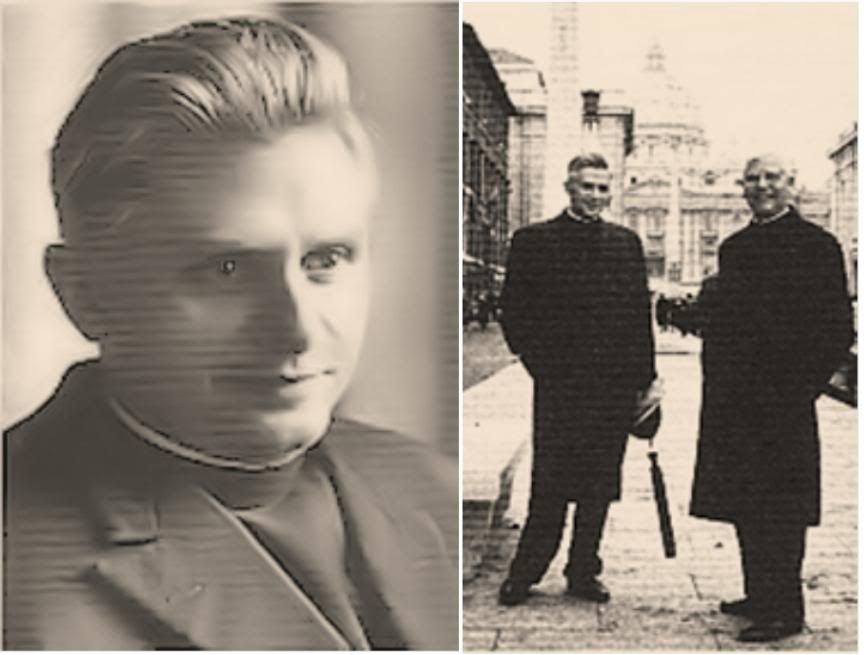 I lifted these two pics from the German edition of Milestones and are captioned, respectively, (on the left), As consultant to Cardinal Frings during Vatican-II (Autumn 1964); (left photo), with Alois Grillmeier, S,J, (made a cardinal by John Paul II in 1994) on the closing day of the Council, 12/8/05.[/DIM} [Forgive the lines of print on the left photo because they show up when the tiny photo from the book is blown up - both photos appear to have been lifted from newspapers. I could clean it from the background but not from his face, unfortunately. I just got the Corel PhotoPro, and haven't had time to familiarize myself with its features - if it's the tool called 'clone brush' that will do the trick (take away the unwanted marks), I can't develop the skill to use it overnight!] Below is what the simple scan from the book looks like, slightly enlarged. The photo on the right is undated but it was probably taken in the mid-60s, too.]
I lifted these two pics from the German edition of Milestones and are captioned, respectively, (on the left), As consultant to Cardinal Frings during Vatican-II (Autumn 1964); (left photo), with Alois Grillmeier, S,J, (made a cardinal by John Paul II in 1994) on the closing day of the Council, 12/8/05.[/DIM} [Forgive the lines of print on the left photo because they show up when the tiny photo from the book is blown up - both photos appear to have been lifted from newspapers. I could clean it from the background but not from his face, unfortunately. I just got the Corel PhotoPro, and haven't had time to familiarize myself with its features - if it's the tool called 'clone brush' that will do the trick (take away the unwanted marks), I can't develop the skill to use it overnight!] Below is what the simple scan from the book looks like, slightly enlarged. The photo on the right is undated but it was probably taken in the mid-60s, too.]
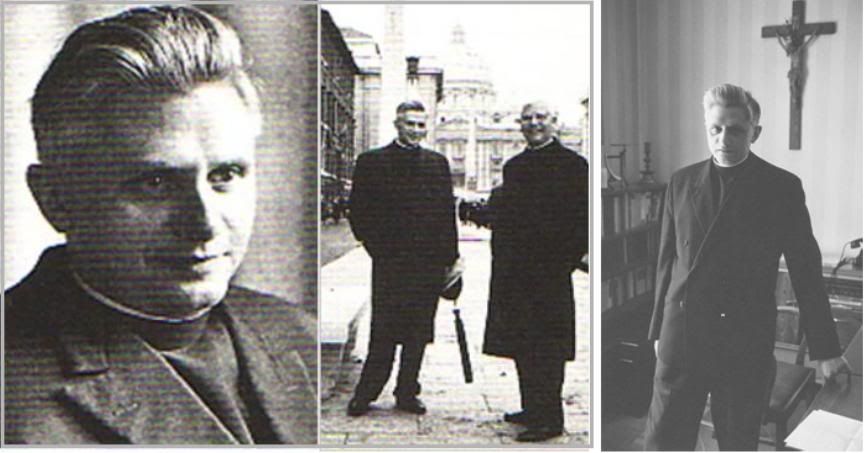
[Modificato da TERESA BENEDETTA 28/03/2011 06:01] |
| |
 28/03/2011 17:23 28/03/2011 17:23 |
|
| | | OFFLINE | | Post: 22.373
Post: 4.998 | Registrato il: 28/08/2005
Registrato il: 20/01/2009 | Administratore | Utente Master | |
|
 Monday, March 28, Third Week in Lent
Monday, March 28, Third Week in Lent
 ST. HESYCHIUS OF JERUSALEM (d ca. 450), Presbyter, Theologian and Exegete
ST. HESYCHIUS OF JERUSALEM (d ca. 450), Presbyter, Theologian and Exegete
Not much is known about him, not even his birth year, but it is known that he was a prolific writer through accounts
handed down after his death. He was known to have written a history of the Church, as well as the issues it faced
in this era, including the Nestorian and Arian heresies. Some of his commentaries on the books of the Bible as well,
along with meditations on the prophets and homilies on the Blessed Virgin Mary, still survive. It is believed he
delivered Easter homilies in the basilica built on the site of the crucifixion. His words on the Eucharist speak to us
today: "Keep yourselves free from sin so that every day you may share in the mystic meal; by doing so our bodies
become the body of Christ." He is particularly venerated in the Russian Orthodox Church.
Readings for today's Mass:http://www.usccb.org/nab/readings/032811.shtml
AT THE VATICAN TODAY
The Holy Father met with
- Seven bishops of the Syro- Malabar Church in India, on ad limina visit. Individual meetings.
{NB: Last week, he met with the Syro-Malankar bishops, another Eastern-rite Church in India.]
- His Beatitude Chrysostomos II, Archbishop of New Justinian and all Cyprus, and Primate of
the Cyprus Orthodox Church, and his delegation.
|
| |
|
|
|
|